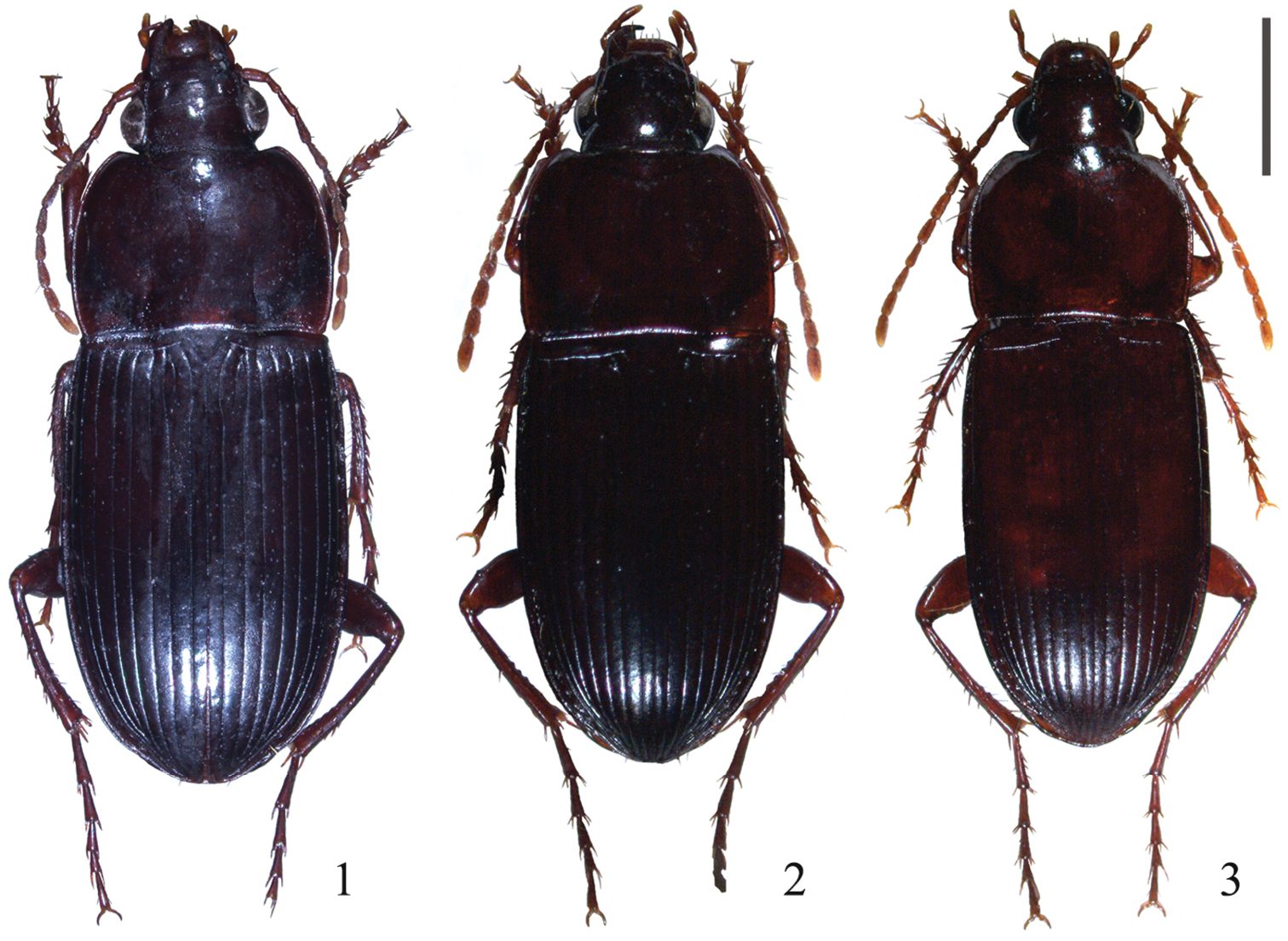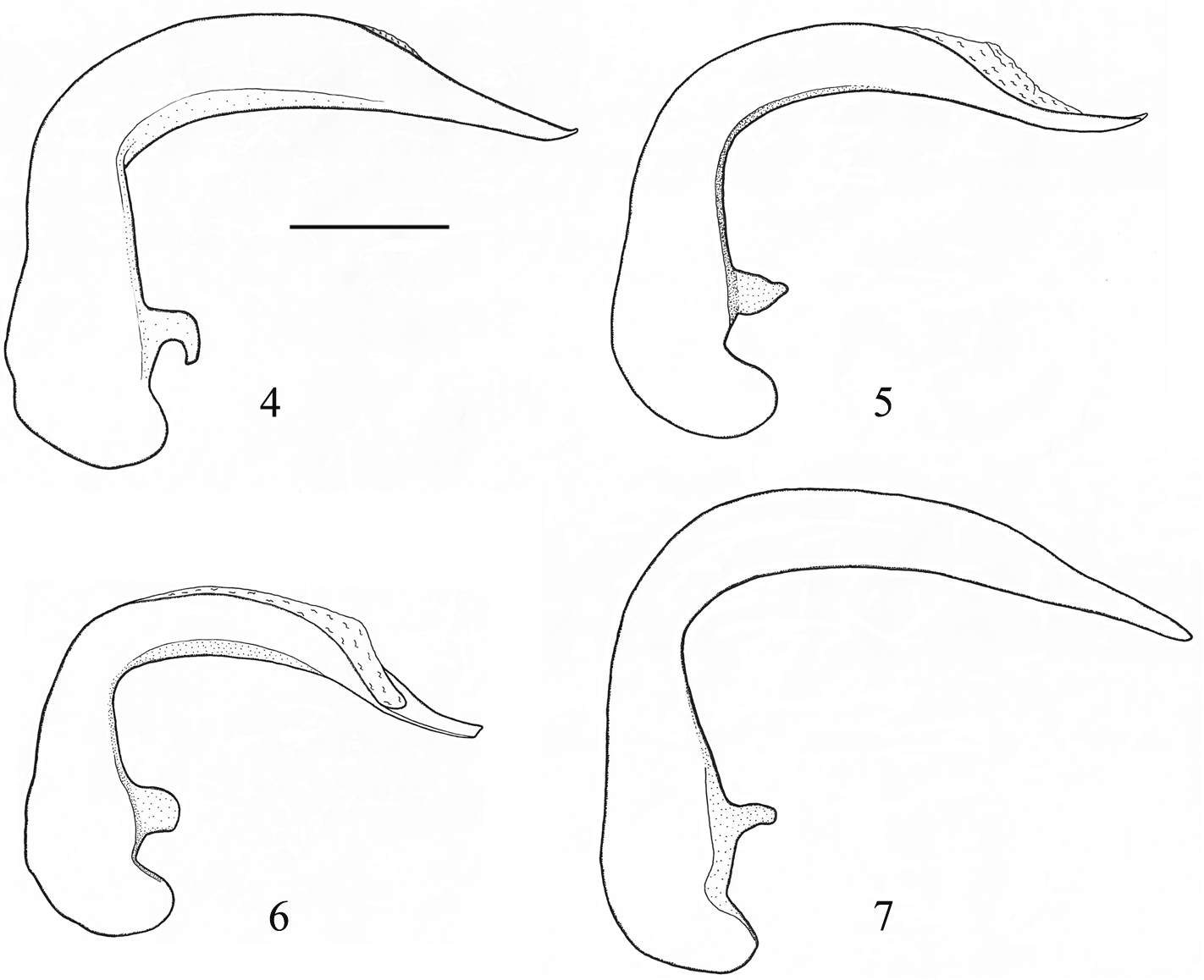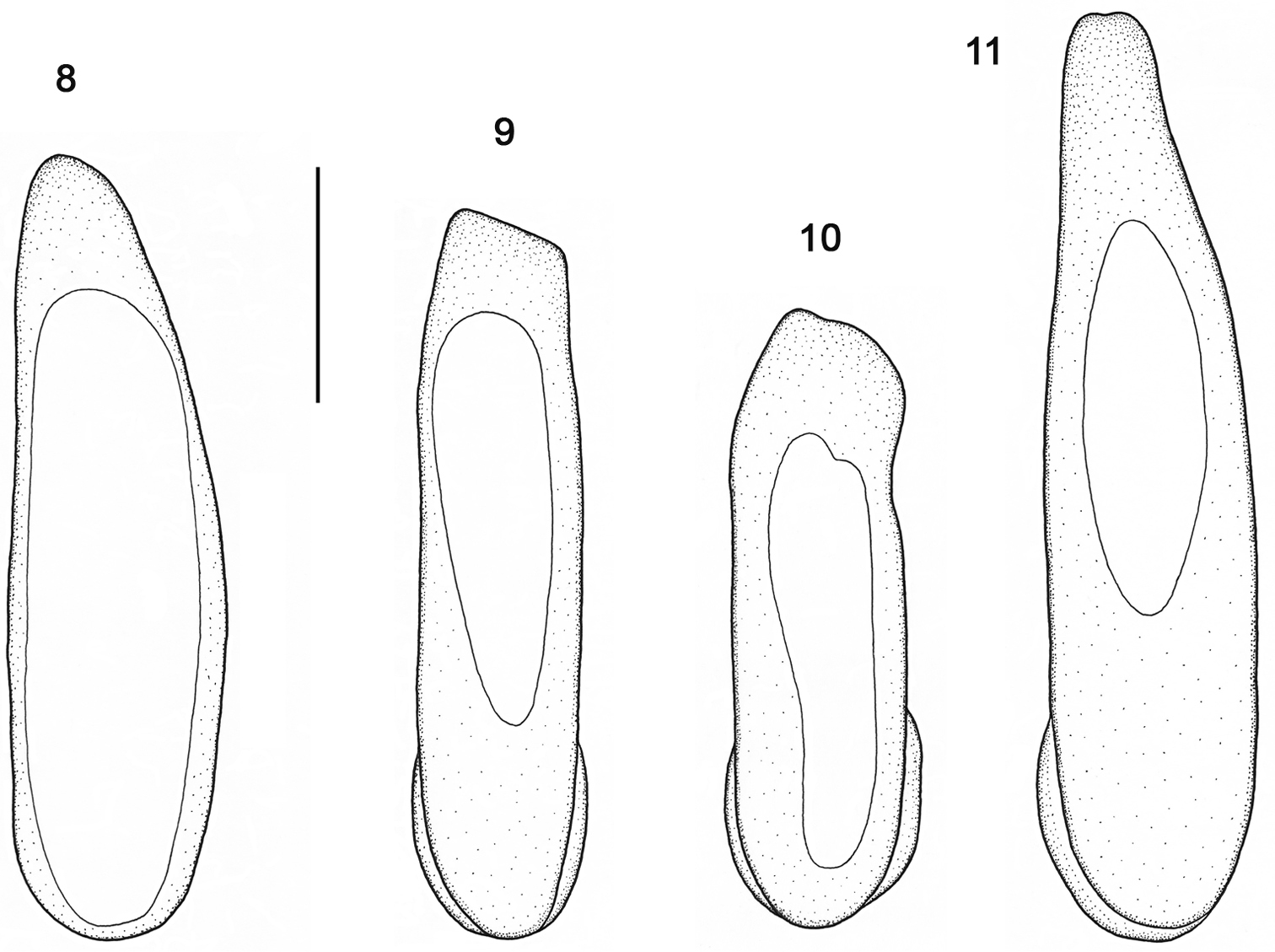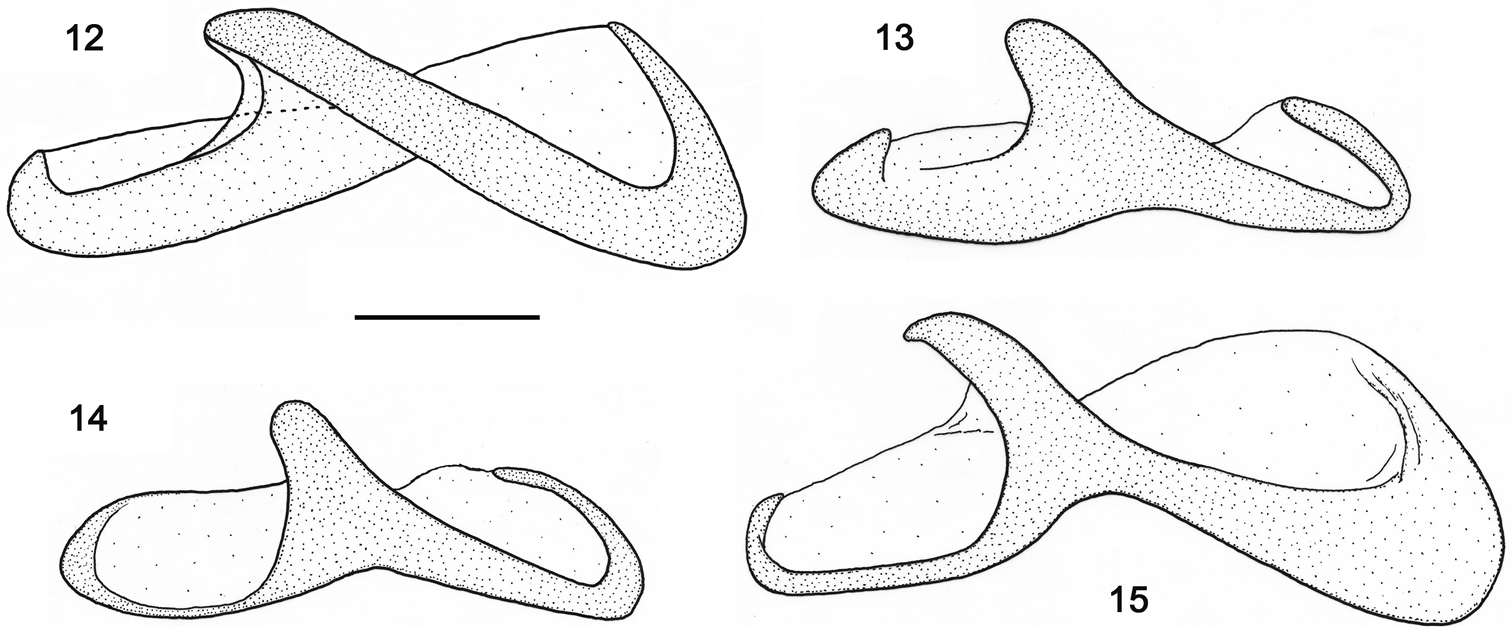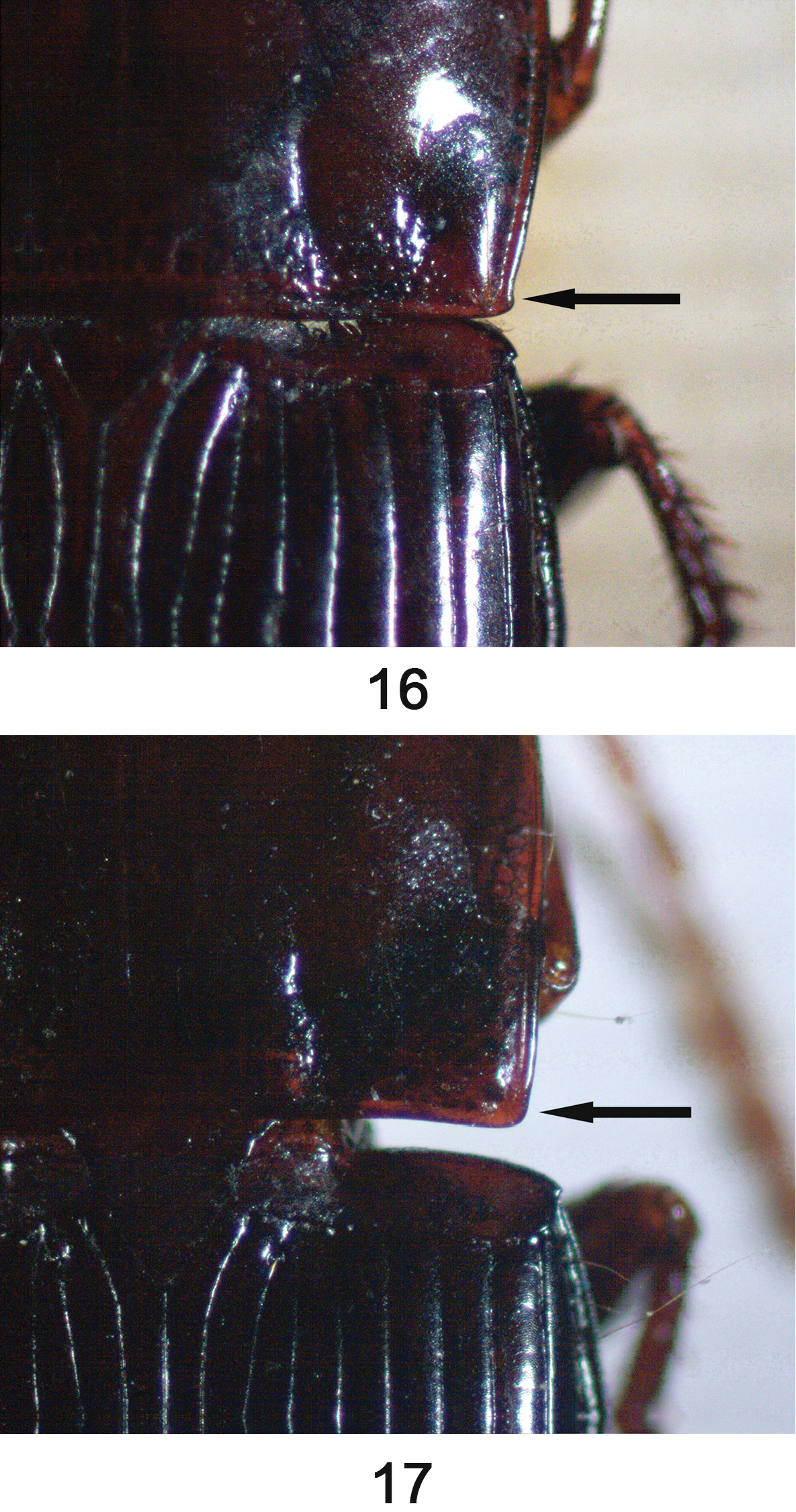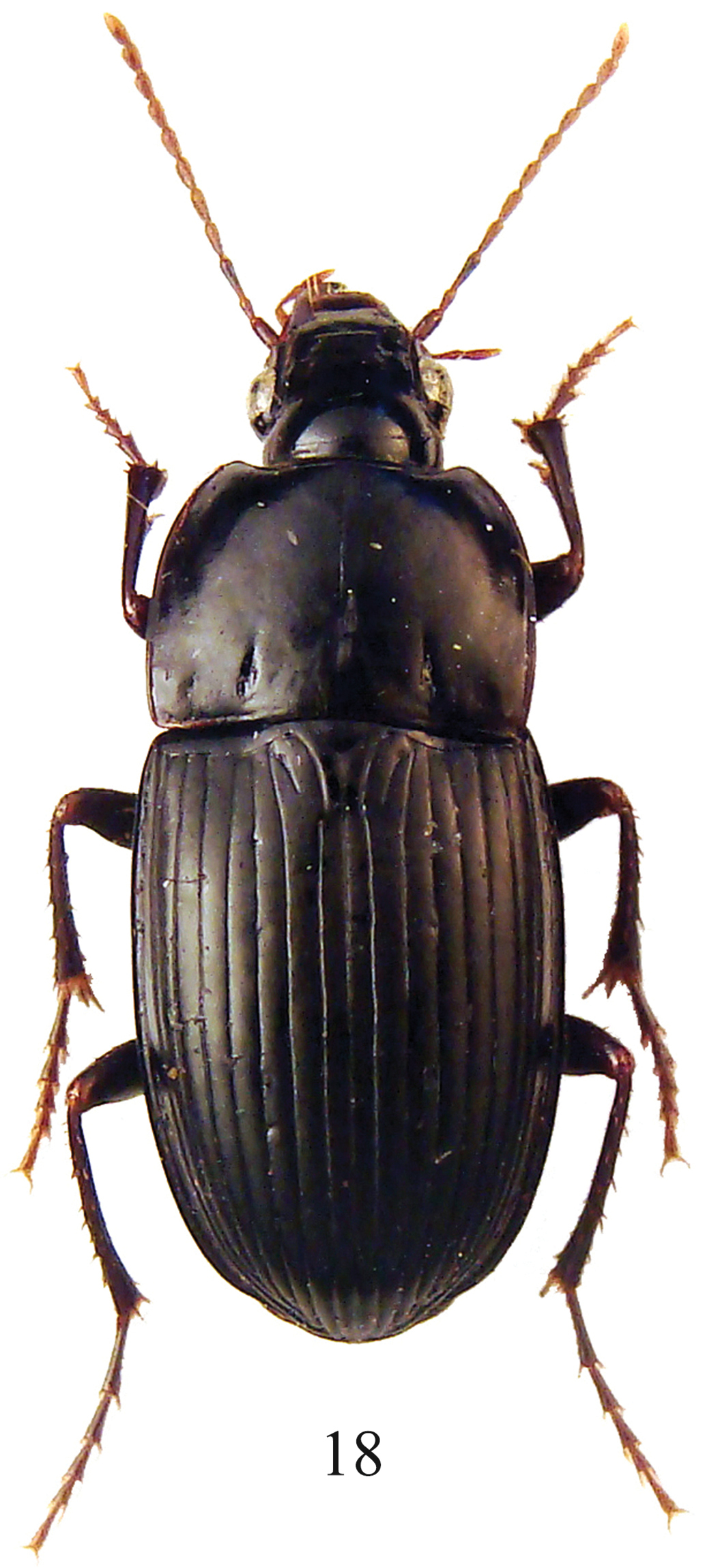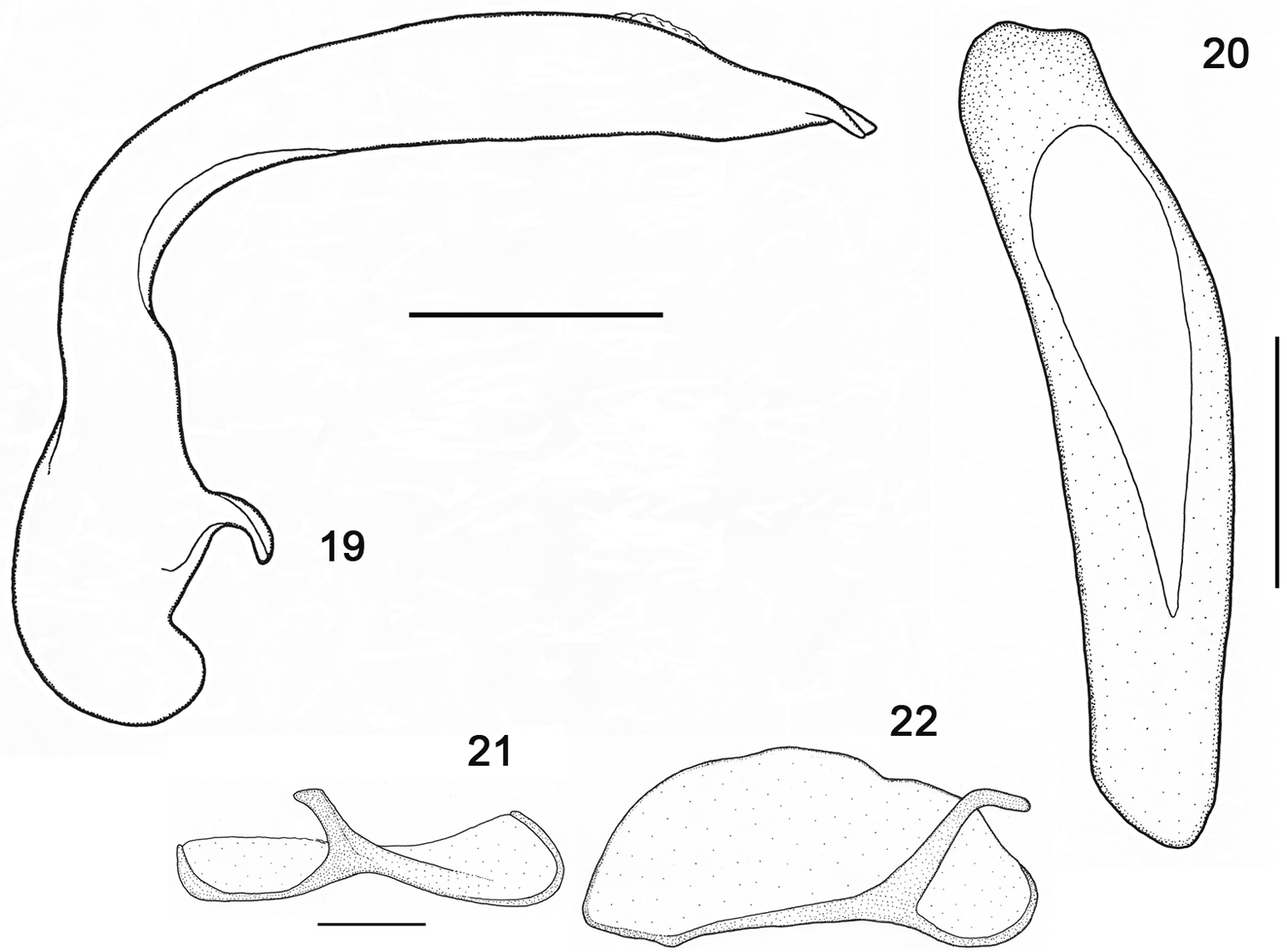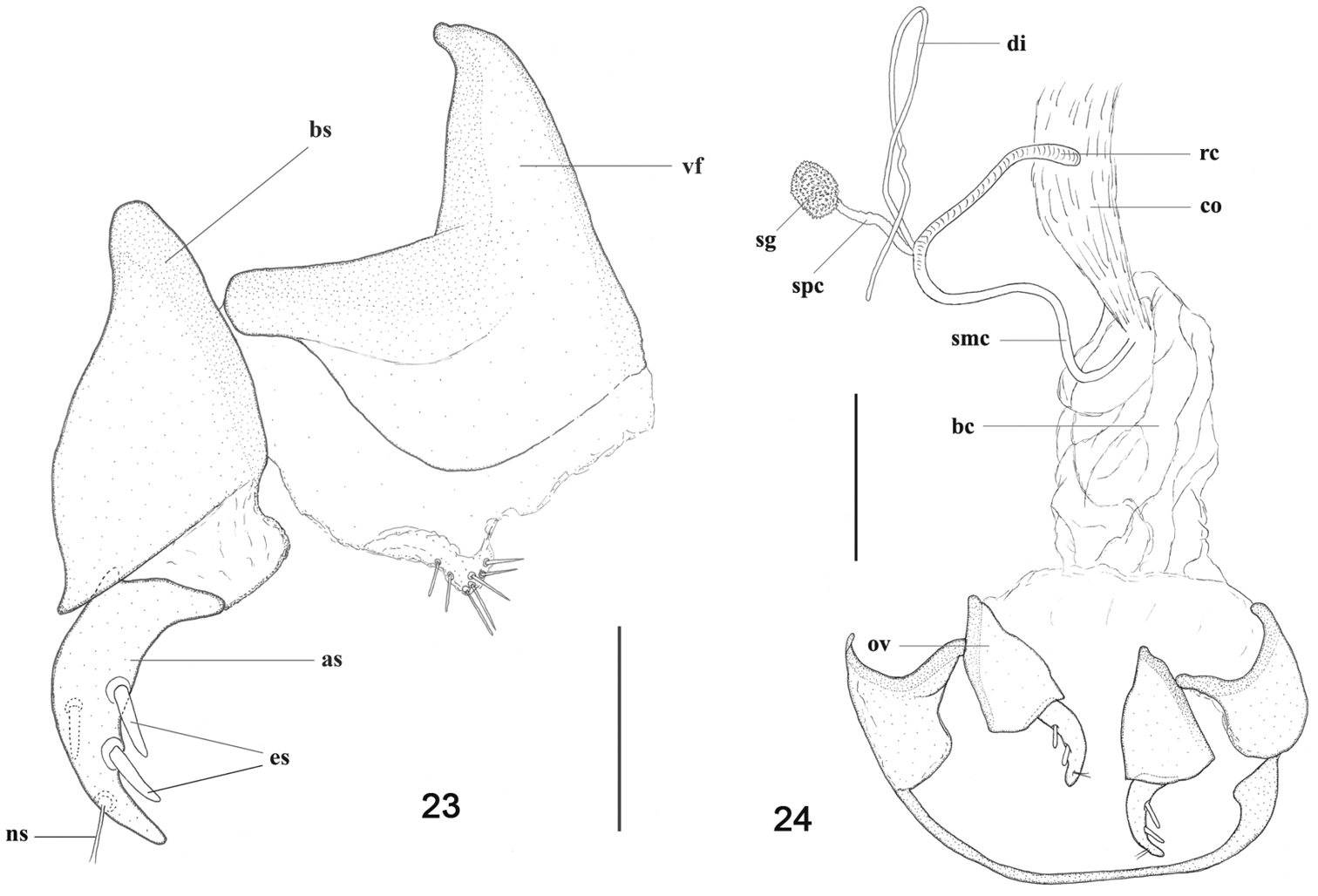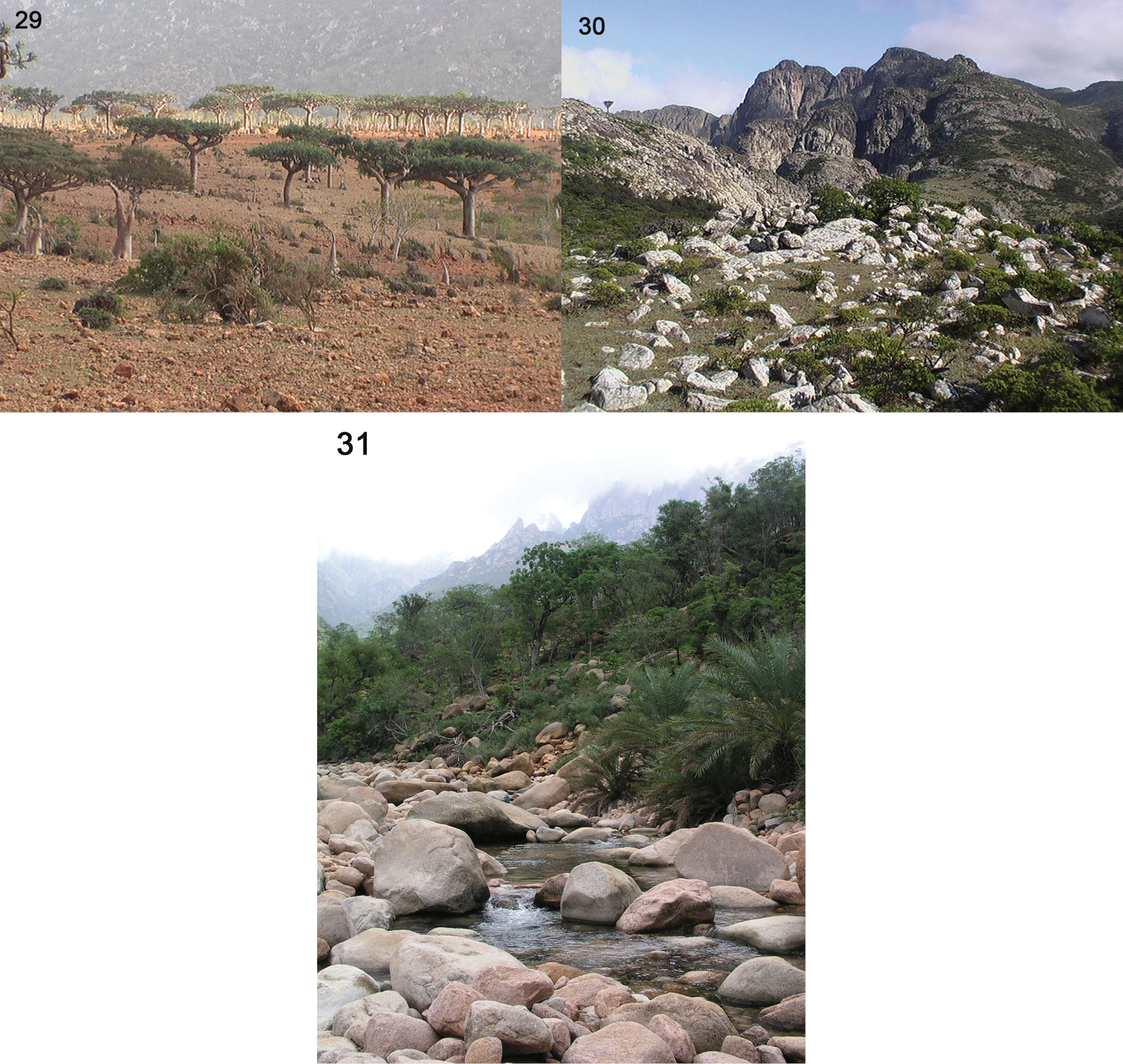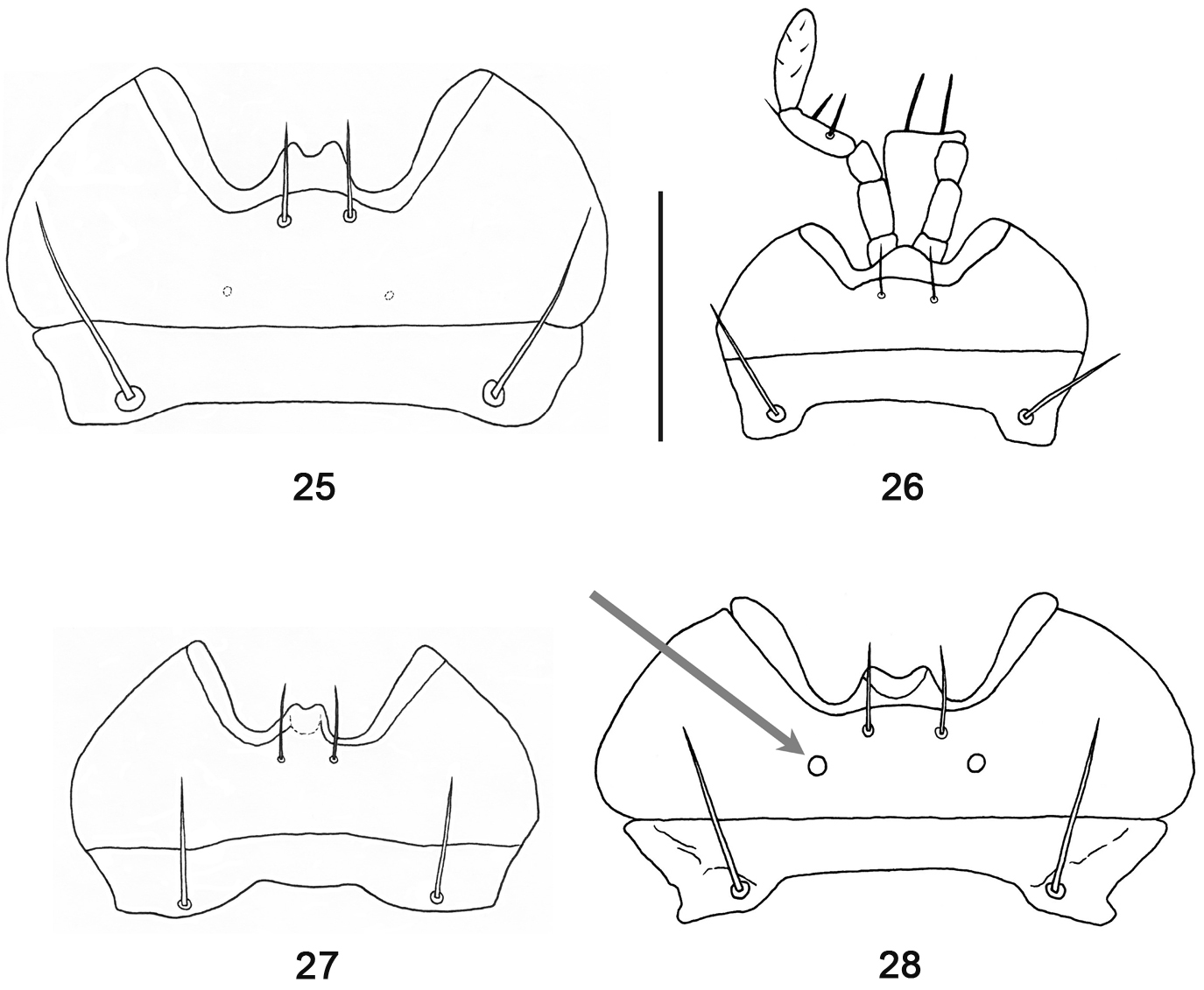






Citation: Guéorguiev B, Wrase DW, Farkač J (2014) Revision of the East Mediterranean Orthomus (Coleoptera, Carabidae, Pterostichini), with description of Parorthomus gen. n. socotranus sp. n. from Socotra Island and key to the Old World genera of subtribe Euchroina. ZooKeys 427: 21–57. doi: 10.3897/zookeys.427.7618
The East Mediterranean species of Orthomus Chaudoir, 1838 are revised. The type series of Feronia longula Reiche & Saulcy, 1855, F. berytensis Reiche & Saulcy, 1855, F. proelonga Reiche & Saulcy, 1855, Orthomus longior Chaudoir, 1873, O. sidonicus Chaudoir, 1873, and O. berytensis akbensis Mateu, 1955 were studied and lectotypes for the first four are designated. Also, the following nomenclatural acts are proposed: Feronia proelonga Reiche & Saulcy, 1855, syn. n. of Orthomus berytensis (Reiche & Saulcy, 1855); Feronia elongata Chaudoir, 1859, syn. n. of Orthomus berytensis (Reiche & Saulcy, 1855); Orthomus sidonicus Chaudoir, 1873, syn. n. of Orthomus longior Chaudoir, 1873; Orthomus velocissimus andalusiacus Mateu, 1957, syn. n. of Orthomus velocissimus akbensis Mateu, 1955, new assignment for Orthomus berytensis akbensis Mateu, 1955. As a result, three species of the genus inhabit the East Mediterranean biogeographical region: O. berytensis, O. longior, and O. longulus. A key to these three species is given. O. longior is recorded for Turkey and Syria for the first time. In addition, a new synonymy of two West Mediterranean taxa is proposed: O. szekessyi (Jedlička, 1956), syn. n. of O. balearicus (Piochard de la Brûlerie, 1868), and a new genus and a species are described: Parorthomus gen. n. socotranus sp. n. (type locality: Republic of Yemen, Socotra Archipelago, Socotra Island, Fimihin env., 530 m.a.s.l.). Illustrations of the species dealt with here are provided including external characters, habitus, mentum and submentum, and genitalia are provided.
Nine genera of the “African Series” of subtribe Euchroina Chaudoir, 1874 are keyed for the first time. Checklists of the species of Orthomus and of the Old World euchroine genera are given.
Coleoptera, Carabidae, Pterostichini, Orthomus, Parorthomus, taxonomy, new genus, new species, new synonyms, lectotype designation, key, checklist, East Mediterranean, Spain, Republic of Yemen
Orthomus Chaudoir, 1838 is a Palaearctic genus of pterostichine carabid beetles with Circum-Mediterranean distribution, which includes 23 species (
A recent work on mitochondrial DNA variations among species of Eutrichopus, Wolltinerfia and Orthomus, found relatively high genetic divergence between them and suggested dealing with these as distinct genera (
All the afore-enumerated taxa together with the Afrotropical genera Abacillius Straneo, 1949 and Abacillodes Straneo, 1988 were referred as to the “African Series” of subtribe Euchroina Chaudoir, 1874 (
The genus Cedrorum Borges & Serrano, 1993 from the Azores does not belong to this series as its only species, Cedrorum azoricus Borges & Serrano, 1993, exhibits a set of features atypical of the euchroines, such as: superficial frontal furrows, submentum with lateral setae, left paramere with a slight transverse aphophysis, falcate right paramere, no transverse sulci on sternites V-VII (contrary to the statement of
The East Mediterranean species of Orthomus were the object of taxonomic reviews quite a while ago (
More than 260 specimens of twenty-four species (and one new to science from Yemen) of Euchroina from the Mediterranean and Afrotropical region were examined: Abacillius basilewskyi Straneo, 1962, Abacillodes jocquei Straneo, 1988, Abacillodes malawianus Straneo, 1988, Orthomus abacoides (Lucas, 1846), Orthomus aquila (Coquerel, 1859), Orthomus aubryi Jeanne, 1974, Orthomus balearicus (Piochard de la Brûlerie, 1868), Orthomus barbarus barbarus (Dejean, 1828), Orthomus barbarus formenterrae (Breit, 1933), Orthomus barbarus penibeticus Mateu & Colas, 1954, Orthomus berytensis (Reiche & Saulcy, 1855), Orthomus dimorphus dimorphus Antoine, 1933, Orthomus dimorphus antoinei Mateu, 1955, Orthomus discors (Wollaston, 1864), Orthomus hispanicus (Dejean, 1828), Orthomus lacouri lacouri (Antoine, 1941), Orthomus lacouri kocheri Mateu, 1955, Orthomus leprieuri Pic, 1894, Orthomus longior Chaudoir, 1873, Orthomus longulus (Reiche & Saulcy, 1855), Orthomus maroccanus Chaudoir, 1873, Orthomus perezii (Martinez & Saez, 1873), Orthomus planidorsis (Fairmaire, 1872), Orthomus rubicundus (Coquerel, 1859), Orthomus starkei Wrase & Jeanne, 2005, Orthomus tazekensis tazekensis (Antoine, 1941), Orthomus tazekensis rifensis Wrase & Jeanne, 2005, Orthomus velocissimus velocissimus (Waltl, 1835), Orthomus velocissimus akbensis Mateu, 1955, Orthomus velocissimus pardoi Mateu, 1957. For comparison we examined also several specimens of Cedrorum azoricus azoricus Borges & Serrano, 1993 and of Cedrorum azoricus caveirensis Borges & Serrano, 1993, a species not belonging to the euchroines.
The lectotypes are designated and validated in order to stabilize the nomenclature in the genus according to Article 74.7.3 of the Code (
Male specimens were boiled in water and their genitalia were extracted, put in 10% KOH solution, then washed and neutralized and then stored in glycerine. The figures were made with Zeiss transmitted-light microscope. After that, the aedeagus and parameres were embedded in Euparal either on the same card with specimen from which they were extracted or on a separate transparent label beneath the specimen from whom they were removed. The measurements and other drawings were made with the aid of an Olympus SZX10 stereobinocular. The photos of habitus and pronotum were made with a Zeiss Stemi 2000 microscope equipped with an AxioCam ERc 5s camera.
Measurements: body length from the apex of the longer mandible to the apex of the longer elytron (BL); maximum linear distance across the head, including the eyes (HW); maximum width of pronotum (PW); length of pronotum, measured from the apical margin to the basal margin along the midline (PL); width of the pronotal base, between the tips of the hind angles (PbW); length of elytra, from a line connecting the apices of the humeral angles to the apex of the longer elytron (EL); maximum width of elytra (EW). The surface of the paramere close-fitting to the distal part of the median lobe of the aedeagus is denoted as internal face, on the contrary the second surface is the external face.
The material examined is housed in the collections listed below:
BMNH The Natural History Museum, London, United Kingdom (Max Barkley)
CRHG Christoph Reuter collection, Hamburg, Germany
DWBG David W. Wrase collection, Berlin, Germany
HLMD Hessisches Landesmuseum Darmstadt, Darmstadt, Germany (Sabine Wamser)
IRSNB Institut Royal des Sciences Naturelles de Belgique, Brussels, Belgium (Alain Drumont)
JFPC Jan Farkač collection, Prague, Czech Republic
JSAG Joachim Schmidt collection, Admannshagen, Germany
MBAP Museo del Dipartimento di Biologia Animale dell’Università, Pavia, Italy (Edoardo Razzetti, Stefano Maretti)
MHNG Muséum d’histoire naturelle, Genève, Switzerland (Julio Cuccodoro)
MIZ Museum and Institute of Zoology, Polish Academy of Sciences, Warszawa, Poland (Dominika Mierzwa)
MNH Entomologie, Muséum National d'Histoire Naturelle, Paris, France (Thierry Deuve, Azadeh Taghavian)
MPHG Manfred Persohn collection, Herxheimweyer, Germany
MRAC Musee Royal de l’Afrique Centrale, Tervuren, Belgium (Marc De Meyer)
NMNHS National Museum of Natural History, Sofia, Bulgaria (Borislav Guéorguiev)
NMPC Národní museum v Prague, Prague, Czech Republic (Jiří Hájek)
NMW Naturhistorisches Museum Wien, Vienna, Austria (Harald Schillhammer)
PSHG Peer H. Schnitter collection, Halle, Germany
RFBN Ron Felix collection, Berkel-Enschot, the Netherlands
TAU National Collection of Insects, Department of Zoology, Tel Aviv University, Israel (Laibale Friedman)
TFPG Thomas Forcke collection, Pforzheim, Germany
VSKC Vladimir Skoupý collection, Kamenné Žehrovice, Czech Republic
ZMAN Zoölogisch Museum Amsterdam, the Netherlands (Ben Brugge)
| 1 | Tarsomeres of all legs glabrous dorsally. Elytra with parascutellar striae well-engraved (long in Orthomus, Abacillodes, Parorthomus gen. n., short in Abacillius) | 2 |
| – | Tarsomeres of all legs pubescent dorsally. Elytra with parascutellar striae vestigial or lacking | 6 |
| 2 | Elytra with discal setiferous punctures in interval 3 / stria 3. Mentum tooth bifid | 3 |
| – | Elytra without discal setiferous punctures. Mentum tooth hardly excavate (Abacillodes aculeatus) or round (Abacillius basilewskyi) at tip | Abacillius Straneo, 1949 |
| 3 | Elytra with two setiferous punctures in interval 3 / stria 3, with last puncture in medial third of elytron | 4 |
| – | Elytra with three to four setiferous punctures in interval 3 / stria 3, with last puncture in posterior third of elytron | Parorthomus gen. n. |
| 4 | Pronotum subquadrate (sides straight or slightly narrowed towards hind angles), with anterior angles slightly to moderately prominent forward. Abdominal sternites V-VII with transverse sulci complete and well-impressed | 5 |
| – | Pronotum subtrapezoid (sides broadened towards hind angles), with fore angles fairly prominent forward. Abdominal sternites V-VII with transverse sulci distinct only laterally (Nesorthomus annae Donabauer, 2008, Nesorthomus bedelianus Lutshnik, 1915 and Nesorthomus dilaticollis Wollaston, 1854) or lacking (remaining species) | Nesorthomus Bedel, 1899 |
| 5 | Species with intercoxal process of prothorax bordered and distribution in the Mediterranean biogeographical region | Orthomus Chaudoir, 1838 |
| – | Species with intercoxal process of prothorax slightly bordered (Abacillodes jocquei) or unbordered (Abacillodes malawianus) and distribution in the Afrotropical biogeographic region (Malawi) | Abacillodes Straneo, 1988 |
| 6 | Smaller species (less than 6 mm), with continental distribution in northwest Africa | Trichopedius Bedel, 1899 |
| – | Larger species (more than 6 mm), with insular distribution in the Macaronesian biogeographical region | 7 |
| 7 | Head with distinct eyes and paraorbital sulci not extended behind posterior margin of eye. Elytra truncate apically | Eutrichopus Tschitschérine, 1897 |
| – | Head with very small or no eyes and paraorbital sulci grooved, extended behind posterior margin of eye toward neck. Elytra rounded apically | 8 |
| 8 | Sides of pronotum straight towards hind angles. Elytra not narrowed basally | Gietopus Machado, 1992 |
| – | Sides of pronotum distinctly concave towards hind angles. Elytra narrowed basally | Wolltinerfia Machado, 1985 |
Abacillius Straneo, 1949 – Republic of South Africa
Abacillodes Straneo, 1988 – Malawi
Eutrichopus Tschitschérine, 1897 – Canary Islands
Gietopus Machado, 1992 – Canary Islands
Nesorthomus Bedel, 1899 – Madeira
Orthomus Chaudoir, 1838 – Canary Islands, Mediterranean
Parorthomus gen. n. – Socotra
Trichopedius Bedel, 1899 – Algeria
Wolltinerfia Machado, 1985 – Canary Islands
The taxon haligena, described from the Salvage Islands belongs to Orthomus berytensis (see
Feronia berytensis Reiche & Saulcy, 1855. Consists of six syntypes, 4 ♂♂, 1 ♀ preserved in MHNG and 1 ♂ in MNHP. The study revealed conspecificity. The specimens in MHNG are placed under a Melly’s taxa label “longulus Reiche, var: berytensis Reiche. ” [handwritten by Melly with pen]. Further, all specimens bear individually the following two labels “Coll. Reiche” [black print on white label] and “Orthomus longulus Reiche var. berytensis Reiche Label MHNG 2010” [black print on white label by Cuccodoro]. In addition, the male selected as lectotype with label, subsequently added: “Lectotype Feronia berytensis Reiche & Saulcy, 1855 B.Guéorguiev & D.W.Wrase des. 2012” [black print on red label], the remaining five: “Paralectotype Feronia berytensis Reiche & Saulcy, 1855 B.Guéorguiev & D.W.Wrase des. 2012” [black print on red label]. The genitalia of the lectotype and of a further male paralectotype from MHNG were examined and glued to cards, pinned beneath the specimens from which they had been removed. The specimen from MNHP is a male, with previously extracted genitalia and glued on a separate card pinned beneath the specimen. This sample bears two old labels equal in size and type: “berytensis type Reiche” [handwritten on white label by Mateu], “Syrie” [handwritten on white label by Chaudoir], as well as a new one: “Paralectotype Feronia berytensis Reiche & Saulcy, 1855 B.Guéorguiev & D.W.Wrase des. 2012” [black print on red label]. All six specimens with a label, subsequently added: “Orthomus berytensis (Reiche & Saulcy) det. B.Guéorguiev” [black print on white label].
We got the information that the part of the Reiche collection housed in MHNG was integrated into the general collection (which was build up essentially from the collection of André Melly) with all specimens with: “Coll. Reiche” but usually there are neither locality, nor identification labels attached to individual specimens, and that identification and locality data figure only on the 'taxa labels' (handwritten by Melly) pinned to the bottom of the drawer, which have thus to be considered as pertaining collectively to the specimens pinned above (Cuccodoro in litt.). The species was described from “Beyruth”, taking into consideration the above mentioned facts concerning labelling of the types we suppose the above mentioned typical specimens as coming from the type locality.
Type material. Feronia longula Reiche & Saulcy, 1855 (specimens belonging to Orthomus berytensis). The type series in MHNG contains two specimens belonging to Orthomus berytensis: 1 ♀, “Jaffa, Syrie” [Reiche's handwriting on yellow label], “Coll. Reiche” [black print on white label], “Orthomus longulus Reiche Label MHNG 2010” [black print on white label by G. Cuccodoro]; 1 ♂, “Coll. Reiche” [black print on white label], “Orthomus longulus Reiche ‘Egypte, Syrie.’ Label MHNG 2010” [black print on white label by G. Cuccodoro], and with labels subsequently added: “Paralectotype Feronia longula Reiche & Saulcy, 1855 B.Guéorguiev & D.W.Wrase des. 2012” [black print on red label], “Orthomus berytensis (Reiche & Saulcy) det. B.Guéorguiev” [black print on white label].
Type material. Feronia proelonga Reiche & Saulcy, 1855. Consists of 2 ♂♂, 2 ♀♀ preserved in MHNG and 1 ♂ in MNHP, all conspecific. The specimens in MHNG are placed under a Melly’s taxa label “var: praelongus Reiche, Palestine” [handwritten by A. Melly with pen]. One male specimen, chosen for lectotype bears the following labels: “Jourdain” [Reiche's handwriting on yellow label], “Coll. Reiche” [black print on white label], “Orthomus praelongu [sic!] Reiche ‘Palestine.’ Label MHNG 2010” [black print on white label by Cuccodoro], “Lectotype Feronia proelonga Reiche & Saulcy, 1855 B.Guéorguiev & D.W.Wrase des. 2012” [black print on red label]. One male and two females from MHNG: “Coll. Reiche” [black print on white label], “Orthomus praelongu [sic!] Reiche ‘Palestine.’ Label MHNG 2010” [black print on white label by G. Cuccodoro], “Paralectotype Feronia proelonga Reiche & Saulcy, 1855 B.Guéorguiev & D.W.Wrase des. 2012” [black print on red label] are accordingly designated. All four specimens with a label, subsequently added: “Orthomus berytensis (Reiche & Saulcy) det. B.Guéorguiev” [black print on white label]. The genitalia of the lectotype and the male paralectype from MHNG examined by ourselves (the apices of both median lobes were found damaged!) and glued to cards together with the respective specimens. The specimen from MNHP, designated as paralectotype, was with previously extracted genitalia. Its aedeagus and parameres are glued to a separate card pinned beneath the specimen. Additionally, this paralectotype bears two old labels equal in size and type: “proelongus type Reiche” [handwritten on white label by Mateu] and “Jourdain” [handwritten on white label by Chaudoir], as well as a new one: “Paralectotype Feronia proelonga Reiche & Saulcy, 1855 B.Guéorguiev & D.W.Wrase des. 2012” [black print on red label]. All specimens with a label, subsequently added: “Orthomus berytensis (Reiche & Saulcy) det. B.Guéorguiev” [black print on white label].
The study of the type material of Feronia proelonga found that this taxon is to be removed from synonymy with Orthomus barbarus barbarus (cfr.
Type material. Feronia elongata Chaudoir, 1859. We were unable to find any type specimen(s) of this taxon, but the description and especially the distribution Chaudoir gave for his species (
Type material. Orthomus longior Chaudoir, 1873 (specimens belonging to Orthomus berytensis). The type series in MNHP contains 3 ♀♀ which belong to Orthomus berytensis. These samples are considered syntypes of Orthomus longior as they and a fourth specimen, which is here designated lectotype of Orthomus longior (for that specimen see under Orthomus longior), were found alongside in the former collection of René and Charles Oberthür who acquired the Chaudoir collection. Each of the three specimens bears the labels: “longior” [red handwritten with ball-pen on white label by Mateu], and, subsequently added: “Paralectotype Orthomus longior Chaudoir, 1873 B.Guéorguiev & D.W.Wrase des. 2012” [black print on red label], and: “Orthomus berytensis (Reiche & Saulcy) det. B.Guéorguiev” [black print on white label].
IMPRECISE LOCALITY: 1 ♂, “Syrie Gory.” (MHNG).
GREECE: 1 ♂, “Graecia” / “Sammlung Schroeder” (MIZ); 1 ♀, “L. Miller Graecia” (ZMAN). Atticí: 1 ♂, “Graecia Attica”, von Oertzen” (ZMAN); 3 ♂♂, 2 ♀♀, “b. Athen v. O.” (ZMAN); 1 ♂, Peloponnes”, X 2009, Umlauf leg. (DWBG). Crete: Rethymno Prefecture, 1 ♀, “Adele, IV.1986, Egger leg.” (NMW).
NORTHERN CYPRUS: Gazimağusa District: 2 ♀♀, Agia Napa, 8.IV.1983, J. Nielsen leg (DWBG); 1 ♂, 2 ♀♀, 3 km W Agia Napa, 9.-14.IV.1999, A. Pütz leg. (DWBG); 1 ♀, Agia Napa env., middle IV 1998, M. Sieber leg. (DWBG); 6 ♂♂, 1 ♀, Ydatodexameni Kouklion, Mantres tou Prastio, ca 16 km W Famagusta, 500 m, 35°07'N, 33°46'E (fallow land with Salicornia/Sueda), 20.II.2011, D.W.Wrase leg. [5] (DWBG); 2 ♂♂, same data but: loamy field edge (DWBG).
UN BUFFER ZONE (Cyprus): 5 spec., Achna dam, 11.12.2006, under stones, K. Austin & E. Small leg. (BMNH, NMNHS).
REPUBLIC OF CYPRUS: Larnaca District: 1 ♂, 2 ♀♀, Pyla [“Pula”], 22.I.1992, J. Hořyna leg. (DWBG).
SYRIA: Gouvernement Dar'a: 1 ♀, Buṣrā (free zone), 100 km S Damascus, 5.XII.2007, R. Kmeco leg. (DWBG).
ISRAEL: 1 ♂, Palestine Negev, 8.2.19, leg. Bythinsky-Salz (TAU); 5 ♂♂, 5 ♀♀, Palestyna Dzebata 25.XII.25 (MIZ). - Jerusalem District: 1 ♂, Kiryat Anavim, 8.4.1948 (TAU). Northern District: 1 spec., Golan, Tel Quazir, 29.3.-26.4.87, Richter leg. (NMW). - Tel Aviv District: 1 ♂, Tel-Aviv, 19.X.1987, G. Coulon leg. (TAU). - Central District: 1 ♂, 1 ♀, SW Khadera (brackish pond), 27.III.2008, D.W.Wrase leg. (DWBG); 2 ♂♂, 1 ♀, Nitsanim, dunes betw. Ashdod and Ashkelon, 29.III.2008, D.W.Wrase leg. (DWBG). - Haifa District: 2 ♂♂, 1 ♀, Atlit, 16.XI.1998, V. Chikatunov leg. (TAU); 2 ♀♀, Salines at Atlit, S Haifa, 30.III.2008, D.W.Wrase leg. (DWBG). - South District: 1 ♀, Revivim, 2.8.1958, Coll. Krystal J. (TAU); 1 ♀, Segula, Qiryat Gat, 5.v.1996, V. Chikatunov leg. (TAU); 1 ♀, Ashdod, 7.12.96, R. Hoffman leg. (TAU); 1 ♂, 1 ♀, Ofaqim, 11.ii.1997, L. Friedman leg. (TAU); 2 ♂♂, 1 ♀, Ha Bsor, Nakhal Bsor, ca 12 km SW Ofakim (banks, leaf litter, under plants, sifted), 22.III.2008, D.W.Wrase leg. (DWBG); 1 ♂, Gilat, SW Jerusalem, E Gaza, 31°20'N, 34°40'E, olive plantation, 29.III.2011, M. Kurtz leg. (MPHG).
Gaza Strip: 8 ♂♂, 5 ♀♀, Env. Gaza, 30.III.1987, W. Heinz leg. (DWBG); 9 spec., Gaza Umg., 29.3.–26.4.87, Richter leg. (NMW).
LIBYA: Tripoli District: 8 spec., Tripoli, 0-20 m, 12-18.04.1998, P. Beron leg. (NMNHS); 1 ♀, Tripoli, IV 1982, Březina leg. (DWBG); 4 spec., Tripoli, Soani Road, 4.XII.1982, V. Pamukov leg. (NMNHS); 1 ♀, 4 km W Sidi Muhammad al Mabkhud, 32°28'53.3"N, 20°56'29.4"E, 333 m, 21.V.2002, A. Reiter leg. (DWBG). - Binghazi District: 1 ♂, 1 ♀, Tolmeitha (Ptolemais), 19.III.2000, J. Kny & P. Rudich leg. (DWBG). - Jabal al Akhdar District: 1 ♂, Susa, Apollonia, 22.II.83, O. Kodym leg. (DWBG).
EGYPT: 2 ♀♀, Cairo-Alexandria, 8.5.1956, W. Kühnell leg. (NMW). - Faiyum Governorate: 4 ♂♂, 2 ♀♀, Kom Oshim, 1.5.1956, W. Kühnell leg. (NMW). - North Sinai Governorate: 1 ♀, El-Arish 11.1.57, A. Sabay leg. (TAU). - Alexandria Governorate: 1 ♂, 100 km S Alexandria, 19.I.1994, W. Ullrich leg. (DWBG). - Beni Suef Governorate: 1 ♂, 1 ♀, El Shanawaya, 1.IX.1994, W. Ullrich leg. (DWBG); 1 ♂, the same but 29.V.1995 (DWBG); 1 ♀, the same but 4.VI.1995 (DWBG); 5 ♂♂, 3 ♀♀, the same but 12.V.1995 (DWBG). - Cairo Governorate: 1 ♂, 1 ♀, Helwan, 19.I.1931, W. Roszkowski leg. (MIZ); 1 ♀, El Maadi, 8.XI.1993, W. Ullrich leg. (DWBG). - Ismaïlia Governorate: 3 ♀♀, Abu Suweir-el-Mahatta, 19.XII.1995, W. Ullrich leg. (DWBG); 1 ♂, Waraura, 4.VI.1995, W. Ullrich leg. (DWBG).
Reported from Greece: Greek mainland (“Attika” [Attica], Ionian Island (“Zante [Zakynthos]),
Orthomus longior Chaudoir, 1873 (specimens belonging to Orthomus longior). Consists of 4 ♀♀ preserved in MNHP, investigation revealed non-conspecificity. Three specimens are identical with the lectotype of Orthomus berytensis (for these specimens see under Orthomus berytensis). The fourth female possesses labels: “Sidon” [handwritten on white label by Chaudoir], “longior” [handwritten in red with ball-pen on white label by Mateu]. This specimen is conspecific with the holotype of Orthomus sidonicus. As only that bears a locality label we choose this one as lectotype of Orthomus longior. This action led to the synonymy of Orthomus longior with Orthomus sidonicus. The two names are published on the same date in the same work (
Type material. Feronia longula Reiche & Saulcy, 1855 (specimens belonging to Orthomus longior). The following three male and one female specimen belong to the type series of Feronia longula (MHNG, see below). The study of the genitalia of all males, as well as the external characters of both sexes proved that all specimens belong to Orthomus longior: 1 ♂, “Beyrouth” [Reiche's handwriting on yellow label], “Coll. Reiche” [black print on white label], “Orthomus longulus Reiche Label MHNG 2010” [black print on white label by G. Cuccodoro]; 1 ♂, “longulus” [Reiche's handwriting on white label], “Coll. Reiche” [black print on white label], “Orthomus longulus Reiche ‘Egypte, Syrie.’ Label MHNG 2010” [black print on white label by G. Cuccodoro]; 1 ♂, “Coll. Reiche” [black print on white label], “Orthomus longulus Reiche ‘Egypte, Syrie.’ Label MHNG 2010” [black print on white label by G. Cuccodoro]; 1 ♀, “Nazareth” [Reiche's handwriting on yellow label], “Coll. Reiche” [black print on white label], “Orthomus longulus Reiche Label MHNG 2010” [black print on white label by Cuccodoro]. All specimens with labels, subsequently added: “Paralectotype Feronia longula Reiche & Saulcy, 1855 B.Guéorguiev & D.W.Wrase des. 2012” [black print on red label], “Orthomus longior Chaudoir, 1873 det. B.Guéorguiev” [black print on white label].
Type material. Orthomus sidonicus Chaudoir, 1873. Holotype ♂ in MNHP, with extracted genitalia. The median lobe and parameres are well preserved and glued on a separate card pinned beneath the specimen. The specimen bears the following labels: “Sidon.” [handwritten on white label by Chaudoir], “sidonicus Chaud.” [handwritten in red with ball-pen on white label by Mateu], and, subsequently added: “Holotype Orthomus sidonicus Chaudoir, 1873” [black print on red label by Guéorguiev], “Orthomus longior Chaudoir, 1873 det. B. Guéorguiev” [black print on white label].
ISRAEL: Northern District: 2 ♂♂, 2 ♀♀, Upper Galilee, Nahal Kziv, 30.i.1999 / 6.iii.1999, M. Finkel (TAU); 1 ♂, 1 ♀, Upper Galilee, Meron Mts., Meron Field School, ca 1000 m (open woodland), 8.–20.III.2008, D.W.Wrase leg. (DWBG); 1 ♂, 1 ♀, Upper Galilee, Meron Mts., Har Meron, 850 m (cedar/pine forest, pitfall trap), 6.V.1996, P. Schnitter & K. Staven leg. (DWBG); 1 ♂, Upper Galilee, Meron Mts., Nakhar (Wadi) Moran, 1 km W Meron field school, ca 900 m (N. slope, slope spring, under stones), 11.III.2008, D.W.Wrase leg. (DWBG); 1 ♀, Upper Galilee, Meron Mts., Har Meron, Kamin Rom, 1100 m, 32°59.447'N, 035°24.669'E (open stony grazing land, limestone), 1.IV.2008 D.W.Wrase leg. (DWBG); 1 ♂, 1 ♀, Upper Galilee, Ya’ar Bar’am, ca 1.5 km W Jish (Gush Khalav), ca. 700 m (edge of oak forest), 9.III.2008, D.W.Wrase leg. (DWBG); 1 ♂, N. Golan Heights, Qalat Nimrod, 300–600 m 7.IV.1985, W. Heinz leg. (DWBG); 1 ♂, Golan Heights 19.iv.1994, M. Warburg leg. (TAU); 2 ♂♂, 1 ♀, Golan Heights, Mas’ada, Ya’ar Odem Reserve, 934 m, 33°13.449'N, 035°45.184'E (grazing woodland, oaks, litter sifted), 21.IV.2006, D.W.Wrase leg. (DWBG); 1 ♂, 1 ♀, Golan Heights, Ya’ar Odem S Mas’ada, 33°13.449'N, 035°45.184'E, 934 m (Quercus boissieri/calliprinos forest, under stones), 10.III.2008, D.W.Wrase leg. (DWBG). - Haifa District: 1 ♀, Haifa [“Syrien Haifa Reitter”] (NMW); Carmel Ridge: 1 ♀, Nahal Oren, Mt. Carmel, 15.11.1995, Pavlicek & Chikatunov leg. (TAU); 3 ♂♂, 4 ♀♀, ‘En Ya’aqov, 23.iii.2006 / 8.ii.2007 / 19.iii.2007, I. Schtirberg’ (TAU).
LEBANON: Muhāfazat Bayrūt: 2 ♀♀, Beirut [“Beyruth, Syr. coll. Plason” / “sidonicus Chd. det. Ing. Jedlička”] (MIZ). 1 ♂, 3 ♀♀, E Bayrūt, Faytroun, 34°.00'N, 35°44'E, ca. 1100 m, 30.X.2012, Chr. Reuter leg. (CRHG, DWBG). 14 ♂♂, 7 ♀♀, S Bayrūt, Dammour env., ca. 200 m, pitfall trap, II 2013, Chr. Reuter leg. (CRHG, DWBG, JSAG, NMNHS). - Chouf District: 1 ♀, Barouk, Mount Lebanon, El Mir massif, 1700-1950 m, 20.V.2006, T. Tichý leg. (DWBG.). - Keserwan District: 4 ♀♀, Balloun at Jitra, S Jounié, 600 m, 9./14.IV.1997, W. Heinz leg. (DWBG). 10 ♀♀, Rayfoun, ca. 33°58'N, 35°42'E, mixed decidous forest, 800–900 m, 18.XI.2012, Chr. Reuter leg. (CRHG, DWBG, JSAG, NMNHS). 1 ♂, 3 ♀♀, same data but: mixed oak forest, ca. 990 m, 15.III.2013 (CRHG, DWBG). 1 ♂, 1 ♀, same data but: 30.III.–15.IV.2013 (CRHG, DWBG).
SYRIA: Al-Lādhiqīyah: 2 ♀♀, Lattaki-Slenfe, 27.4.1990, Reuter leg. (NMW); 1 ♂, Şlinfah, Abal an Nusayriah Mt., 1200 m, 24.–26.V.1995, P. Kabátek leg. (DWBG); 2 ♂♂, 5 ♀♀, Jabāl Ansarya, At Tammāzah, 790 m, 34.15.404N, 030.10.136E, 20.XII.2006, R. Sehnal leg. (DWBG); 1 ♀, Slenfeh, 18.4.2010, Vl. Skoupý leg. (VSKC).
TURKEY: Antalya Province: 1 ♀, Alanya-Yayla, 1000 m, 13.5.1987, Steiner leg. (NMW); 1 ♀, Manavgat, Kiselot, 3.1.91, 10 m HN, Wunderle leg. (NMW); 1 ♂, Antalya env., 8.II.1999, J. Blümel leg. (DWBG); 1 ♂, 1 ♀, Avsallar near Incekum beach, 22 km W Alanya, 9.-23.V.1995, A. Pütz leg. (DWBG); 2 ♀♀, Incekum, env. Avsallar, under stone, II 1999, Schlarbaum leg. (TFPG); 3 ♂♂, 1 ♀, Gedevit-Yayla near Alanya, ca 1100 m, 10.IV.1992, W. Heinz leg (DWBG, JSAG); 1 ♂, Karaburu near Alanya, middle V 1997, M. Sieber leg. (DWBG); 1 ♂, Manavgat env., 3.I.1991, V. Assing leg. (DWBG); 1 ♀, E. Taurus Mts., Çaltepe env. (Manavgat District), 1600 m, 37.18N, 31.12E (subalpine), 10.–14.VI.2004, P. Croy leg. (DWBG). - Hatay Province: 1 ♀, W Yayladaği, 475 m, 35°54'30.8"N, 36°01'11.3"E, 05.-10.05.2006, Schnitter leg. (PSHG).
1 ♀, Amasya: Amasya [“Amasia coll. Kraatz”] (DWBG).
(15 specimens examined).
Turkey (only Antalya and Hatay Province), Syria (only Latakia Governorate), Lebanon (several coastal districts), North Israel (Northern District; Haifa District). First species records to Turkey and Syria.
Feronia longula Reiche & Saulcy, 1855 (specimens belonging to Orthomus longulus). The type series of Feronia longula consists of 11 syntypes, 4 ♂♂, 6 ♀♀ of them in MHNG and 1 ♂ in MNHP. The specimens in MHNG are placed under a Melly’s taxa label “longulus Reiche., Egypte, Syrie” [handwritten by Melly with pen] pinned to the bottom of the drawer, which thus are to be considered as pertaining collectively to all specimens. Our revision revealed that the specimens in MHNG are not conspecific but belong to three distinct species. Three males and one female belong to Orthomus longior (for these specimens see under Orthomus longior), while another male and another female belong to Orthomus berytensis (for these specimens see under Orthomus berytensis). Only four females are representatives of Orthomus longulus, labelled individually as follow. One female selected for lectotype: “…” [handwritten remnant on small quadratic yellow label], “Beyrouth” [Reiche's handwriting on brown label], “Coll. Reiche” [black print on white label], “Orthomus longulus Reiche Label MHNG 2010” [black print on white label by Cuccodoro], “Lectotype Feronia longula Reiche & Saulcy, 1855 B.Guéorguiev & D.W.Wrase des. 2012” [black print on red label]; 3 ♀♀, “Coll. Reiche” [black print on white label], “Orthomus longulus Reiche ‘Egypte, Syrie.’ Label MHNG 2010” [black print on white label by Cuccodoro], “Paralectotype Feronia longula Reiche & Saulcy, 1855 B.Guéorguiev & D.W.Wrase des. 2012” [black print on red label]. The specimen from MNHP is a male, with previously extracted genitalia and glued to a separate card pinned beneath the specimen. The most part of its aedeagus is destroyed, certainly by a species of the genus Anthrenus Geoffroy, 1762, but the apical lamella is still preserved. This male is conspecific with the above last four females from MHNG and it is designated as paralectotype, too: “longulus type Reiche” [handwritten on white label by Mateu], “Paralectotype Feronia longula Reiche & Saulcy, 1855 B.Guéorguiev & D.W.Wrase des. 2012” [black print on red label]. All five specimens, pertaining to the true longulus, with a label, subsequently added: “Orthomus longulus (Reiche & Saulcy) det. B.Guéorguiev” [black print on white label].
ISRAEL: - Northern District: 1 ♂, “Palestine. …Galilee XII.1924 O. Theodor.” (BMNH); 1 spec., “Nazaret, 17.3.-3.4.87, Kfar …. L. Blumenthal leg.” (NMW); 3 ♂♂, 5 ♀♀, Megiddo, Ein Ha’emek, 230 m, Getreideacker, 08.V.1996, Schnitter & Staven leg. (DWBG); 1 ♂, 4 ♀♀, “Merom Golan, 12.VI.2000, V. Chikatunov leg.” (TAU); 2 ♂♂, 3 ♀♀, Upper Galilee, N. sea shore of Sea of Galilee, Ein Sheva (Tabkha), -192 m, 32°52.453'N, 035°32.726'E (stony and loamy pasture), 25.IV.2006, D.W.Wrase leg. (DWBG); 1 ♂, Lower Galilee, ca 4 km W Tamra, (route 70), 32°51.799'N, 035°10.292'E (loamy field edge), 25 m, 25.IV.2006 D.W.Wrase leg. (DWBG); 1 ♂, 6 ♀♀, Upper Galilee, Ha Khula Valley, Ma’agar Einan lake, 73 m, 33°05.137'N, 035°34.730'E (toe of dam, in moist loamy soil), 1./2.V.2006 D.W.Wrase leg. (DWBG, JSAG); 1 ♂, Bir el Maksur, 32°45.901'N, 035°13.883'E, 23.II.2005, W. Starke leg. (DWBG); 1 ♀, Nazareth, Kfar ?Hochbreeh, 17.III.-3.IV.1987, Blumenthal leg. (DWBG). - Haifa District: 2 ♂♂, 2 ♀♀, Haifa [“Syrien Haifa Reitter”] (BMNH, MHNG, MIZ, NMW); 1 ♀, Mount Carmel, 23.XII.25 (MIZ); 4 ♀♀, Haifa, 15.XII.1941 / 8.I.1942 / 4.XII.1954 Bytinski-Salz (TAU); 1 ♀, Nahal Oren, Mount Carmel, 18.3.1996, Pavliček & Chikatunov leg. (TAU); 1 ♀, Haifa, Check Post, 8.II.2000, V. Chikatunov & T. Pavliček leg. (TAU); 1 ♂, Mount Carmel, Ya’ar ha- Ya’aramin ca. 500 m (under stones), 30.III.2008, D.W.Wrase leg. (DWBG).
1 ♂, “42 St.” / “Orthomus berytensis Reich. Portugal Dr Stierlin (above), 2. b. (underneath)” (MHNG).
(9 specimens examined).
North Israel (Northern District; Haifa District), Lebanon (Beyrouth, type material).
| 1 | Abdominal sternites densely and deeply punctured and rugose laterally | 2 |
| – | Abdominal sternites superficially punctured or smooth laterally | 3 |
| 2 | Pronotum with hind angles obtuse at tip, often with small denticles protruding laterally (Fig. 16). All discal setiferous punctures of elytra as a rule situated close to or in stria 3. Elytral striae smooth, sometimes with a shallow punctuation. Mesepisternum smooth or with shallow punctuation only. Elytral microsculpture in females consisting of isodiametric meshes almost regularly arranged (as in Orthomus longior). Median lobe of aedeagus toward apex distinctly shifted to the left, apical lamella narrowed distally, almost round at tip (dorsal aspect) (Figs 4, 8). | Orthomus berytensis (Reiche & Saulcy, 1855) |
| – | Pronotum with hind angles almost right-angled, rounded at tip (Fig. 17). Second discal setiferous punctures of elytra mostly adjoining stria 2 (rarely one or two punctures in the middle of interval 3; by exception one puncture adjoining stria 3). Elytral striae ± strongly punctured throughout. Mesepisternum with distinct, dense and coarse punctuation. Elytral microsculpture in females somewhat irregular, consisting of isodiametric meshes mixed with little transverse meshes. Apical lamella of median lobe with a single angle at left side, right side rounded (dorsal aspect) (Figs 6, 10) | Orthomus longulus (Reiche & Saulcy, 1855) |
| 3 | Elytral striae smooth, sometimes with a weak punctuation laterally and apically, situation of elytral discal punctures as in Orthomus longulus. Elytral microsculpture in females consisting of isodiametric meshes almost regularly arranged (as in Orthomus berytensis). Pronotum with hind angles almost right-angled at tip, with small denticles protruding laterally, similar to Orthomus berytensis (populations from Turkey) or with hind angles somewhat obtuse-angled, rounded at tip, as in Orthomus longulus, rarely with suggestion of a denticle (populations from Lebanon, Syria, Israel). Apical lamella of median lobe angled at both sides (dorsal aspect) (Figs 5, 9) | Orthomus longior Chaudoir, 1873 |
Habitus. 1 Orthomus berytensis (Reiche & Saulcy, 1855), male, “Tel-Aviv” 2 Orthomus longior Chaudoir, 1873, male, “Upper Galilee, Ya’ar Bar’am” 3 Orthomus longulus (Reiche & Saulcy, 1855), male, “Upper Galilee, Ha Khula Valley, Ma’agar Einan lake”. Scale bar = 2 mm.
Median lobe of aedeagus, lateral view. 4 Orthomus berytensis (Reiche & Saulcy, 1855), lectotype of Feronia berytensis 5 Orthomus longior Chaudoir, 1873, paralectotype of Feronia longula Reiche & Saulcy 6 Orthomus longulus (Reiche & Saulcy, 1855), male, “Megiddo” 7 Orthomus velocissimus akbensis Mateu, 1955, holotype of Orthomus barbarus akbensis. Scale bar = 0.5 mm.
Median lobe of aedeagus, dorsal view. 8 Orthomus berytensis (Reiche & Saulcy, 1855): lectotype of Feronia berytensis 9 Orthomus longior Chaudoir, 1873, paralectotype of Feronia longula Reiche & Saulcy 10 Orthomus longulus (Reiche & Saulcy, 1855), male, “Megiddo” 11 Orthomus velocissimus akbensis Mateu, 1955, holotype of Orthomus barbarus akbensis. Scale bar = 0.5 mm.
Right paramere, internal face. 12 Orthomus berytensis (Reiche & Saulcy, 1855): lectotype of Feronia berytensis 13 Orthomus longior Chaudoir, 1873, paralectotype of Feronia longula Reiche & Saulcy 14 Orthomus longulus (Reiche & Saulcy, 1855), male, “Megiddo” 15 Orthomus velocissimus akbensis Mateu, 1955, holotype of Orthomus barbarus akbensis. Scale bar = 0.2 mm.
Pronotum posterior right angle. 16 Orthomus berytensis (Reiche & Saulcy, 1855), male, “Tel-Aviv” 17 Orthomus longior Chaudoir, 1873, male, “Upper Galilee, Ya’ar Bar’am”.
Orthomus barbarus akbensis Mateu, 1955. Holotype ♂ (IRSNB): “Holotypo” [print on red label], “Syrie Akbes” [print on white label], “Orthomus barbarus subsp. akbesensis [sic!] mihi J. Mateu det., 1951” [mixed handwritten & print on white label]. Genitalia extracted, well preserved, glued to a separate card pinned beneath the specimen.
PORTUGAL: - Faro: 1 ♂, Lagos env. 27./28.X.2006, V. Neuman leg. (cWR). 1 ♀, E Bensafrim, N Lagos, 28.III.1995, Chr. Bayer leg. (cWR). 1 ♀, Sagres, 4.IV.1989, M. Sachez (cWR). 1 ♂, 1 ♀, Sagres, 1 km from coast, 9.IV.1992, V. & C. Neumann leg. (cWR). 1 ♂, Sierra Monchique, Cabo de Sáo Vicente, 11.V.1992, V. & C. Neumann leg. (cWR). 1 ♂, 2 ♀♀, Carvoeiro, 10.V.1997, B. Nickel leg. (cWR).
SPAIN: - Córdoba: 1 ♂, Córdoba, escuela, 10.IV.2003, T. Tichý leg. (cWR). - Granada: 1 ♂, La Herradura, 27.XII.1998-3.I.1999, G. Siering leg. (cWR). - Málaga: 1 ♂, Malaga, 28.VIII.1996, P. Beron leg. (NMNHS). 1 ♀, “Sierra de Tejeda, Competa S, 600 m, 6.4.2001, Ch. Bauer leg.” (NMNHS).
Orthomus berytensis akbensis was described from “Akbes, Siria”, based on a male and a female specimen. Mateu characterized it as having the pronotal base not bordered bilaterally, the pronotum widest at about middle, and with basal fovea punctured, the elytral striae hardly punctured, the metatibia in male crenulate at internal side, and the median lobe (
The study of the structure of the median lobe of aedeagus and the parameres, as well as selected external features in the holotype of Orthomus barbarus akbensis demonstrated that it is really different from the other three East Mediterranean species. Its comparison with various taxa of the genus revealed that it is identical with specimens of Orthomus velocissimus andalusiacus Mateu, 1957 (compare Figs 4, 8, 12 and
The name malacensis Mateu was used as an infrasubspecific one (as also transiens) and is therefore not available according to Article 45.5 of the Code (
The application of Art. 72.4.4 specifies the type locality of Orthomus malacensis Jeanne.
1. abacoides Lucas, 1846: 46 (Oodes) – Algeria
= trapezicollis Chaudoir, 1859: 117 (Feronia)
= occidentalis Gautier des Cottes, 1870: 299
= modestus Reiche, 1871: 427 [replacement name]
Note1: See Note2 under Orthomus barbarus.
2. achilles Wrase & Jeanne, 2005: 888 – Algeria
3. aquila Coquerel, 1859: 768 (Feronia) – Algeria
= numidus Chaudoir, 1859: 118 (Feronia)
4. aubryi Jeanne, 1974: 68 – Spain
5. balearicus Piochard de la Brûlerie, 1868: lxxx (Feronia) – Balearic Islands
= szekessyi Jedlička, 1956: 392 (Pterostichus) syn. n.
6.1. barbarus barbarus Dejean, 1828: 261 (Feronia) – Portugal, Spain, France
? rectangulus Fairmaire, 1859: li (Feronia)
= expansus Mateu, 1957: 98
= logronicus Mateu, 1957: 98 [unav.]
6.2. barbarus formenterrae Breit, 1933: 67 (Pterostichus) – Balearic Islands
6.3. barbarus penibeticus Mateu & Colas, 1954: 53 – Spain
Note1: Feronia rectangulus described from Batna, Algeria, probably is to fall in synonymy with another species of Orthomus, rather than with Orthomus barbarus.
Note2:
Note3: Pterostichus (Orthomus) szekessyi Jedlička, 1956 was described from the Balearic Islands, based on a male without an exact locality (Jedlička, 1956). The holotype is stored in the collections of the Magyar Természettudományi Múzeum, Budapest and one of us (DWW) has examined it. It is in fairly good condition, the right last four antennomeres and the left metatarsus are lacking. The specimen was originally pinned and subsequently glued to card, with aedeagus not extracted (now it is glued to a separate card beneath the specimen). It is labelled with: “Balearen” [handwritten on white label], “Typus” [black print on red label], “Pterostichus (Orthomus) Sze’kessyi sp.n. det. ING. JEDLIČKA” [red label, species name handwritten in black by Jedlička, the rest printed]. It agrees in all characters, including the construction of the median lobe of the aedeagus, with these ones of Orthomus balearicus. Hence, we propose the synonymy of Pterostichus (Orthomus) szekessyi with Feronia balearicus Piochard de la Brûlerie, 1868. The specimen is additionally labelled with “Orthomus balearicus PIOCHARD DE LA BRȖLERIE, 1868 D.W. Wrase det. 2014” [black print on white label].
7. berytensis Reiche & Saulcy, 1855: 618 (Feronia) – Sardinia, Sicily, Malta
= proelongus Reiche & Saulcy, 1855: 619 (Feronia) syn. n. – Greece, Turkey, Cyprus
= elongatus Chaudoir, 1859: 116 (Feronia) syn. n. – Syria, Lebanon, Israel
= haligena Wollaston, 1860: 87 (Pterostichus) – Canary Islands, Morocco
? varinii Gautier des Cottes, 1866: 178 (Feronia) – Tunisia, Libya, Egypt
= atlanticus Fairmaire, 1875: 543 (Feronia)
= oceanicus Mateu, 1951: 283 [unav.]
= muluyensis Antoine, 1957: 205
Note1: Feronia varinii described from Sardinia, is most probably a synonym of Orthomus berytensis rather than of Orthomus barbarus.
8.1. dimorphus antoinei Mateu, 1955: 70 – Morocco
8.2. dimorphus dimorphus Antoine, 1933: 85 – Morocco
9. discors Wollaston, 1864: 47 (Pterostichus) – Canary Islands
= persimilis Harold Lindberg, 1950: 2 (Pterostichus)
10. hispanicus Dejean, 1828: 260 (Feronia) – Spain
= quadrifoveolatus Chaudoir, 1859: 117 (Feronia)
11.1. lacouri haroldi Pupier & Coulon, 2013: 221 – Morocco
11.2. lacouri kocheri Mateu, 1955: 68 – Morocco
11.3. lacouri lacouri Antoine, 1941: 38 (Platysma) – Morocco, Algeria
11.4. lacouri pupieri Jeanne, 1988: 12 – Algeria
12. leprieuri Pic, 1894: 104 – Algeria, Tunisia
13. longior Chaudoir, 1873: 105 – Turkey, Syria, Lebanon
= sidonicus Chaudoir, 1873: 110 syn. n. – Israel
14. longulus Reiche & Saulcy, 1855: 616 (Feronia) – Lebanon, Israel
15. maroccanus Chaudoir, 1873: 108 – Spain, Morocco
= humeralis Antoine, 1957: 208 [unav.]
16. perezii Martínez & Saez, 1873: 57 (Feronia) – Spain
17. planidorsis Fairmaire, 1872: 420 (Feronia) – Spain, France
18. poggii Leo & Magrini, 2002: 510 – Italy (Isola il Toro)
19. rubicundus Coquerel, 1859: 769 (Feronia) – Algeria, Tunisia
= modicus Coquerel, 1859: 770 (Feronia)
= manogramma Chaudoir, 1859: 119 (Feronia)
= minutus Reiche, 1871: 427
20. starkei Wrase & Jeanne, 2005: 882 – Morocco
21.1. tazekensis rifensis Wrase & Jeanne, 2005: 885 – Morocco
21.2. tazekensis tazekensis Antoine, 1941: 411 (Platysma) – Morocco
= scutellaris Antoine, 1941: 412 [unav.]
22.1. velocissimus akbensis Mateu, 1955: 74 – Spain
? hesperica Motschulsky, 1849: 73 (Feronia)
= transiens Mateu, 1957: 99 [unav.]
= malacensis Mateu, 1957: 99 [unav.]
= andalusiacus Mateu, 1957: 103 syn. n.
= malacensis Jeanne, 1981: 45
22.2. velocissimus pardoi Mateu, 1957: 102 – Spain
22.3. velocissimus velocissimus Waltl, 1835: 53 (Argutor) – Spain
Note1: For Feronia hesperica see remarks under Orthomus velosissimus akbensis.
Parorthomus socotranus sp. n.
A Euchroina genus of beetles that are medium-sized (8.2-10 mm), black coloured, brachypterous, with the following combination of characters: convex eyes; mentum with bifid tooth and large labial pits; pronotum sides posteriorly straight to slightly convex; elytra with 3-4 (rarely 2 or 5) discal setiferous puncture in stria 3/interval 3, with last puncture in posterior third of elytron; intercoxal process of prothorax subquadrate, distinctly bordered at sides and backwards; metaepisterna as wide as long; abdominal sternites V–VII with transverse basal sulci complete and well-impressed; mesotibia and metatibia straight in both sexes, mesotibia distally with slight inner callus in males; tarsomeres glabrous dorsally, with segment 5 setose ventrally; distal part of median lobe of aedeagus considerably curved to left in dorsal aspect; spermatheca with appended gland spherical and elongate diverticulum.
None required because the genus is monobasic, and its characters are the same as those of its type species.
A prefix in apposition (masculine), formed from the Greek παρά-, meaning “beside”, “near”, “alongside”, and the name of the Mediterranean pterostichine genus Orthomus to which the new taxon is related.
http://zoobank.org/3D5BF7E1-9EB4-47FB-92C5-7E2C7D958916
Holotype ♂, “Yemen, Socotra Isl., Fimihin, GPS 12.474N, 54.015E, 530 m, x.2000, leg. V. Bejček & K. Št’astný” (DWBG) / “HOLOTYPE Parorthomus socotranus sp. n. Guéorguiev, Wrase & Farkač des. 2014” [black print on red label, black framed]. Paratypes 24 ♂♂, 29 ♀♀, labelled as follow: 4 ♂♂, 4 ♀♀, with the same data as the holotype (DWBG, JFPC, JSAG, NMNHS); 6 ♂♂, 10 ♀♀, “Soqotra-Archipel: Soqotra Hoq, Küstenebene bis Höhleneing., Kalk mit einigen Granitfelsen, dichte Veg., 50–320 m 12°36'N, 54°21'E, 5.–6.2.1999 leg.: H. Pohl, SOQ 08” (BMNH, DWBG, HLMD, MPHG); 3 ♀♀, “YEMEN: Socotra Isl. Haghier, 4.-8.X.2000 lgt. V. Bejček & K. Št’astný” (JFPC); 2 ♂♂, 1 ♀, “Yemen, Soqotra-Archipel, Soqotra, Wadi Danegan, Barberfallen, 90 m 12°36'59"N, 54°03'48"E, 28.–30.10.2000 leg.: T. VAN HARTEN & H. POHL SOQ 2000/02a” (HDLM); 2 ♂♂, “Yemen, Soqotra-Archipel, Soqotra, Homhil, Quelle mit Ficus, Licht 12°34'13"N, 54°18'32"E/leg. H. Pohl, 29.10.2000/SOQ 2000/13” (HDLM, MPHG); 1 ♂, “Yemen, Soqotra-Archipel, Soqotra, Wadi Danegan, 90 m 12°36'59"N, 54°03'48"E, 30.10.2000 leg.: T. VAN HARTEN” “SOQ 2000/02” (HDLM); 3 ♂♂, 1 ♀, “Yemen, Soqotra Is.; 28.–29.ix.2003 HOMHIL protected area N 12°34'27" E 54°18'32" 364 m [GPS]; Jan Farkač lgt.” / “YEMEN – SOQOTRA 2003 Expedition; Jan Farkač, Petr Kabátek & David Král” (JFPC, NMNHS); 1 ♂, 1 ♀, “Yemen, Socotra Is., WADI AYHAFT, 24.-26.xi.2003, 12°36'38’’N, 53°58'49’’E, 190 m, [GPS], leg. P. Kabátek” / “YEMEN – SOQOTRA 2003 Expedition; Jan Farkač, Petr Kabátek & David Král” (DWBG); 1 ♂, 1 ♀, “Yemen, Soqotra Is., 2.xii.2003, Al Haghier mts. W slopes, skant area 12°35'52"N, 54°00'01"E 1240 m [GPS], D. Král leg.” / “YEMEN – SOQOTRA 2003 Expedition; Jan Farkač, Petr Kabátek & David Král” (NMPC, RFBN); 1 ♂, “Yemen, Soqotra Is., QAAREH (waterfall), Noged plain, 5.-6.xii.2003, 12°20'10"N, 53°27'56"E, 57 m [GPS], leg. P. Kabátek” / “YEMEN – SOQOTRA 2003 Expedition; Jan Farkač, Petr Kabátek & David Král” (DWBG); 1 ♀, “Yemen, Soqotra Is., 6.–7.xii.2003 Noged plain: WADI IREEH N12°23'11", 53°59'47"E, 96 m [GPS]; Jan Farkač lgt.” / “YEMEN – SOQOTRA 2003 Expedition; Jan Farkač, Petr Kabátek & David Král” (DWBG); 2 ♀♀, “Yemen: Socotra Isl., Wadi Ayhaft, lat. +1395751.449, lon +824616.2897, 27-30.10.2007, pitfall traps, F. Pella leg.” (MBAP); 1 ♀, “YEMEN: Socotra Island E 410 m, 3. ii. 2010 N12°29'41", E 54°09'30" L. Purchart & J. Vybíral lgt.” (NMPC); 1 ♀, “YEMEN: Socotra Island E Homhil area, 410-510 m, 12°34'25"N, 54°18'53"E 9–10. ii. 2010 L. Purchart & J. Vybíral lgt.” (NMPC); 1 ♂, “YEMEN: Socotra Island Aloove area, Hassan vill. env. 12°31.2'N, 54°07.4'E, 221 m Jiři Hájek leg. 9–10.xi.2010” (NMPC); 2 ♀♀, “YEMEN: Socotra Island Al Haghier Mts. Scant Mt. env. 12°34.6'N, 54°01.5'E, 1450 m J. Bezděk 12-13.xi.2010” (NMPC); 2 ♂♂, 1 ♀, “YEMEN, Socotra Island Hagher Mts., Scand Mt. env. montane evergreen woodland 16.–18.vi.2012 12°34.6'N, 54°01.5'E, 1450 m” / “SOCOTRA expedition 2012 J. Bezděk, J. Hájek, V. Hula, P. Kment, I. Malenovský, J. Niedobová & L. Purchart leg.” (NMNHS, NMPC). All paratypes with label: “PARATYPE Parorthomus socotranus sp. n. Guéorguiev, Wrase & Farkač des. 2014” [black print on red label, black framed].
A brachypterous, black coloured species of Euchroina (Fig. 18), with moderately convex, amariform facies, with testaceus appendages, convex eyes, segment 11 of antennae not reaching basal margin of pronotum, elytra with very slight or reduced humeral denticle, elytral interval 3 with three to four (rarely two or five) discal setiferous punctures adjoining stria 3, with last puncture on posterior third of elytron, metaepisterna as long as wide, and median lobe of aedeagus curved to left distally, with apical lamella slightly emarginated at tip.
Parorthomus socotranus sp. n., female paratype, habitus.
Values for sizes and ratios among specimens from the type series are shown in Table 1.
Data on variation in some values among type specimens of Parorthomus socotranus sp. n.
| type | sex | n | BL/mm | PW/HW | Ø | PW/PL | Ø | PW/PBW | Ø | PL/EL | Ø | EL/EW | Ø |
|---|---|---|---|---|---|---|---|---|---|---|---|---|---|
| HT | ♂ | 1 | 9.2 | 1.72 | – | 1.41 | – | 1.13 | – | 0.43 | – | 1.45 | – |
| PT | ♂♂ | 10 | 8.2–9.6 | 1.69–1.86 | 1.77 | 1.42–1.49 | 1.46 | 1.05–1.13 | 1.10 | 0.41–0.45 | 0.43 | 1.40–1.49 | 1.44 |
| PT | ♀♀ | 12 | 8.4–10.0 | 1.68–1.86 | 1.76 | 1.43–1.51 | 1.47 | 1.05–1.14 | 1.10 | 0.41–0.44 | 0.42 | 1.37–1.45 | 1.40 |
Body length 8.2–10.0 mm (9.2 mm in holotype); width 3.2–3.9 mm (3.6 mm in holotype), maximum width behind the middle of elytra. Head, pronotum, elytra, segments III–IV (in the most cases) of antennae, and ventral surface (without mouthparts) black in mature specimens, light to dark brown in immature specimens; labrum, mandibles, mentum, segments I–II and V–XI of antennae, and sometimes sides of pronotum testaceus; maxillary palpomeres, labial palpomeres, and labium rufous; coxae, femora, and tibiae of legs dark brown or testaceus, trochanters and tarsomeres mostly rufous.
Microsculpture distinct on the whole dorsal and ventral surfaces (including coxae, trochanters and femora), consisting of isodiametric and slight transversal meshes, more apparent in females (female specimens almost matt on dorsal surface, males somewhat shiny), reduced on the most part of the clypeus and gula.
Head noticeably longer and narrower with respect to the pronotum, frons smooth, frontal furrows well-marked, divergent posteriorly, reaching the level of anterior supraorbital punctures; neck without constriction posteriorly; eyes fairly large, convex, moderately prominent, with diameter as long as the combined length of segment I-II of the antennae, temporae short, as long as or shorter than half of eye diameter; paraorbital sulci moderately deep, encircling eyes behind; clypeus trapezoidal, separated from frons by fine suture, with anterior margin slightly concave; labrum rectangular; antennae moderately long, pubescent from second fourth of segment IV, the apex of terminal segment not reaching basal margin of pronotum; mentum transverse, deeply emarginate, with large labial pits, median tooth slightly bifid at tip, epilobes narrow, slightly projecting beyond lobes; submentum with medial setae, without lateral ones (Fig. 28).
Pronotum wide, transverse, sub-trapezoid, widest about middle, with margins distinctly, narrowly bordered (the bordering reduced in the middle quarter of apical margin, and sometimes in the middle of basal margin, just between the internal basal impressions); sides somewhat more constricted apically than basally, with two pairs of setiferous punctures, lateral punctures situated at about end of apical third, posterolateral ones situated near hind angles, near to lateral margin and close to basal margin; apical margin moderately emarginate, narrower than basal margin, fore angles rounded, moderately projecting; basal margin nearly straight, slightly concave in the middle, hind angles almost rectangular, rounded at tip; basal impressions somewhat variable in extension and size, internal ones always present, linear, narrow and falcate, diverging toward base, impunctate, deeper and longer than the outer ones, outer impression present or reduced becoming evanescent, when present then mostly faint, foveolate, somewhat punctate; disc slightly convex, midline well-impressed, long, not reaching both anterior and posterior margins.
Elytra sub-elongate, moderately convex, widest at about the second third, fused at suture; shoulders well-marked, obtusely angulate; basal margin complete, reaching stria 1 inwards, forming a very minute denticle at humerus; discal striae moderately impressed, impunctate, parascutellar striae distinct, striae 1-8 joining basal margin; intervals slightly flat, smooth, interval 3 with three to four (rarely two or five) setiferous punctures adjoining stria 3, with last puncture in posterior third of elytron, rarely in about middle of interval 3 (see also Variability); scutellar setiferous puncture present; hind wings reduced to small scales.
Prosternum, mesosternum, middle of metasternum, proepipleura, epipleura of elytra, and abdominal sternites (excl. sides of sternites 1-3) smooth, impunctate, proepisterna and sides of sternites 1-3 slightly punctured, mesepisterna, metepisterna, and sides of metasternum more or less roughly punctured; intercoxal process of prothorax subquadrate, distinctly bordered at sides and backwards; metaepisterna short, sub-quadrate, moderately narrowed toward behind, its anterior border longer than internal and posterior ones, as long as external border.
Abdominal sternites IV-VI with transverse basal sulci complete (continuous) and well-impressed, abdominal sternum VI with posterior margin rimmed throughout, with one pair of foveate setigerous punctures medially in males and two pairs in females.
Legs slender, relatively long; protibia apically moderately but abruptly enlarged at internal margin in males; mesotibia and metatibia straight in both sexes, mesotibia with slight inner callus distally in males; tarsomeres 1-5 glabrous dorsally, segment 5 setose ventrally; segments 1-3 of male protarsi moderately expanded.
Male genitalia (5 specimens dissected). Median lobe of aedeagus slender (Figs 19–20), narrower at middle, with basal part long, almost rectangularly bent behind apical part, narrowest at middle, from there toward apical lamella rectilinear, right external angle of apical lamella somewhat bent down, left external angle elevated (left lateral view), median lobe from middle part shifted to left, with right margin moderately convex, lengthwise appreciably elevated over left margin, left margin concave towards apex, apical lamella wide, rounded on left side, obtusely angled on right side, with a slight front concavity (dorsal view), ostium slightly deflected to right; right paramere narrow and elongate, smaller than left one, with a slanting lateral process (Fig. 21); left paramere conchoid (Fig. 22).
Parorthomus socotranus sp. n., paratype, male genitalia: 19 median lobe of aedeagus, left lateral aspect 20 median lobe of aedeagus, dorsal aspect 21 right paramere, internal face 22 left paramere, internal face. Scale bars = 0.5 mm (Figs 19–20), 0.2 mm (Figs 21–22).
Female genitalia (3 specimens dissected). Ovipositor (Fig. 23), with valvifer more chitinized proximally and less distally, its distal margin having a setose and moderately chitinized area, basal stylomere large, conical, apical stylomere smaller, falcate, with two dorsolateral ensiform setae and one dorsomedial ensiform seta, sensorial pit distinct with two long nematiform setae; spermathecal complex (Fig. 24) with copulatory bursa proximally slightly gooseneck-like (this character not visible in Fig. 24), spermatheca with seminal canal and receptaculum slightly differentiated [undifferentiated type, according to
Parorthomus socotranus sp. n., paratype, female genitalia, ventral view: 23 left ovipositor 24 female reproductive tract (spermathecal complex and ovipositor). Legend: as apical stylomere; bc bursa copulatrix; bs basal stylomere; co common oviduct; di diverticulum; es ensiform setae; ns nematiform setae; ov ovipositor; rc receptaculum of spermatheca; smc seminal canal of spermatheca; sg appended gland of spermatheca; spc spermathecal canal; vf valvifer. Scale bars = 0.2 mm (Fig. 23), 0.5 mm (Fig. 24).
Interval 3 with three to four (rarely two or five) setiferous punctures adjoining stria 3, with last puncture in posterior third of elytron, rarely in about middle of interval 3. The number of punctures can increase to five or decrease to two, often the number of punctures of the left and the right elytron is unequal. Also the position of the punctures can somewhat vary. While the first two discal punctures always adjoin stria 3 (and so also the majority of the following punctures), sometimes the third puncture is located on the middle of interval or adjoins stria 2, rarely, the fourth discal pore is located on the middle of interval 3 or adjoins stria 2.
For variability of body size and indices see ‘Description’ and Table 1.
The specific epithet is an adjective, referring to Socotra, the island where the new species was collected.
Up to present only known from Socotra.
Habitats of Parorthomus socotranus sp. n. in Socotra. 29 Homhil protected area, November 2003 30 Al Haghier Mts., December 2003 31 Wadi Ayhaft, January 2004 (all photographs by JF).
A mesotopic to eurytopic epigeic beetle, collected from the end of September to the first ten days of February, and on higher ground (Hagher Mts., Scand Mt. env., 1450 m) some specimens were also found in June. From the list of localities, the species seems to be quite widespread across Socotra from the mouths of wadis (near or far off the water) till the highest mountains. Referring on
The Socotra Archipelago is a Gondwanan continental fragment, which has experienced a long period of geological isolation. This landmass was separated from the Arabian plate during the rifting which began to open the Gulf of Aden in the Oligocene to Miocene epochs (
At present, it is difficult to ascertain whether Parorthomus socotranus sp. n. derived from ancestral populations on the Arabian mainland that probably reached Socotra by transoceanic dispersal in relatively recent geological times, or it is a descendent of an ancestor and evolved in situ in the course and after the separation of the island. Notwithstanding, a few taxonomic and biogeographic facts are consistent with the hypothesis that the species is not a phyletically young descendant of continental populations.
Combinations of distinguishing features (see ‘Diagnosis’, Key to the genera of the “African Series” of Euchroina) clearly distinguish the new genus from the other related genera. However, some character states: 1/ mentum tooth bifid (Fig. 28); 2/ sides of pronotum straight or slightly convex posteriorly (Fig. 18); 3/ elytra with setiferous punctures in interval 3 (Fig. 18); 4/ intercoxal process of prothorax bordered; 5/ abdominal sternites V-VII with transverse sulci, complete and well-impressed; 6/ tarsomeres 1-5 of all legs glabrous dorsally; 7/ segment 5 of tarsomeres setose ventrally; 8/ aedeagus with sides nearly equally broadened in the distal half, with apical lamella wide, nearly rounded at tip (Fig. 20); 9/ appended spermathecal gland with diverticulum (Fig. 24), show that the new species may be related to two geographically “close” genera, the Afrotropical Abacillodes and the Mediterranean Orthomus. The two species from the first genus and the new species share characters 1-3 and 5-8. Some species from the second genus and Parorthomus socotranus sp. n. divide states 1-7 and 9 between, while the last taxon and Orthomus velocissimus s.l. possess all the listed character states.
Mentum and submentum, ventral aspect (gray arrow indicating labial pits): 25 Orthomus barbarus barbarus (Dejean, 1828), female, Spain, “Laguna Salinas (Alicante)” 26 Abacillius basilewskyi Straneo, 1962, holotype 27 Abacillodes jocquei Straneo, 1988, holotype 28 Parorthomus socotranus sp. n., male paratype, “Fimihin”. Scale bar = 0.5 mm.
The median lobe with sides nearly equally broadened along the distal half and apical lamella wide, rounded or semi-rounded at tip in the new species looks alike the median lobe in the Afrotropical Abacillodes (see
Besides, we infer that the presence of three to four discal setiferous punctures (by exception, two or five punctures on one elytron only) in the elytral interval 3 or stria 3, with the last puncture in posterior third of elytron, is another clear apotypic feature in the new taxon. This state occurs in no other species among the Old World Euchroina, except Parorthomus socotranus sp. n. The most species of the subtribe have two discal punctures in the elytral interval 3, as the second one lies at the posterior third of elytron. The species of Abacillius have no discal punctures on the elytron.
Parorthomus socotranus sp. n. has a unique combination of two apotypic characters, distal third of the aedeagus considerably curved to the left in dorsal aspect (i), and presence of 3-4 discal setiferous puncture in elytral stria 3/interval 3, with the last puncture situated in the posterior third of elytron (ii), which is indication for a long-time existing isolation and merit surely the erection of an own genus. The absence of close relative/s sharing together with the new species these two marked structural features exclude a close relationships and suggests that we deal with an ancient lineage which most probably arisen within the basic stem of the “African Series” of Euchroina (according to
In spite of all, special character states and main ecologic preference in Parorthomus socotranus sp. n. suggest that it is phylogenetically closer to Orthomus and Abacillodes than to any other genus. The exact phylogenetic position within the euchroines can be disclosed only after investigation of more taxa, especially from the Old World, including also genetic technics and providing cladistic analysis, this could probably also identify its sister taxon.
The presence of large labial pits on the mentum is a trait in the new taxon that is worth noting. Each pit has a distinct, deep aperture, its diameter wider than the diameter of the labial pore, and both are situated more medially (Fig. 28). The distinct labial pits, destined to a particular function of use, seem to be a plesiotypic condition in Pterostichini (
So far, 53 species of ground beetles have been recorded from the Socotra Archipelago (
Holotype ♀, “Holotypus” [printed on salmon colored label], “Little berg summits Themeda Grassland 5500–6000 ft.” [printed], “cathedral peak forestry reserve. natal drakensberg. March 1959 B. R. & P. J. Stuckenberg” [printed], “Col. Mus. Congo don. B. Stuckenberg Coll. P. Basilewsky” [printed & handwritten], “Abacillius Basilewskyi n.sp. S.L. Straneo det. 1960 Holotypus“ [printed & handwritten], “RMCA ENT 000019508” [printed] (MRAC).
Holotype ♂, “Holotypus” [printed on salmon colored label], “Lichenya Plateau 2000m 5/24.XI.1981” [printed], “Coll. Mus. Tervuren Malawi South. Reg. Mount Mulanje XI. 1981 - R. Jocqué” [printed], “Holotypus Abacillodes jocquei Str.” [printed & handwritten on red label], “Abacillodes jocquei n. sp. det. S.L. Straneo 1987 Holotypus ♂” [printed & handwritten], “RMCA ENT 000019509” [printed] (MRAC).
Remarks. A striking characteristic in the type species of Abacillodes, Abacillodes jocquei, are the elytral intervals 2, 4, and 6, significantly wider than the adjacent uneven intervals. But, this character state is not present in Abacillodes malawianus, thus it can not be used as a generic distinguishing mark.
Holotype ♀, “Holotypus” [printed on salmon colored label], “Lichenya Plateau 2000m 15/17.XI.1981” [printed], “Coll. Mus. Tervuren Malawi South. Reg. Mount Mulanje XI. 1981 - R. Jocqué” [printed], “Holotypus Abacillodes malawianus Str.” [printed & handwritten on red label], “Abacillodes malawianus n.sp. det. S.L. Straneo 1987 Holotypus ♂” [printed & handwritten], “RMCA ENT 000019510” [printed] (MRAC).
We are grateful to all curators and collectors listed in the section ‘Material and methods’ for sending us material for study upon their responsibility or helping us with useful information. Ron Felix (Berkel-Enschot, the Netherlands) and Manfred Persohn (Herxheimweyher, Germany) who made a significant part of the type series of the new species available and Paulo Borges (Universidade dos Açores, Azores, Portugal) gifted us a series of Cedrorum azoricum. We thank Johannes Bergsten (Naturhistoriska riksmuseet, Stockholm, Sweden), Ron Felix, Jiří Hájek (NMPC), Marc De Meyer (MRAC), Jose Serrano (Universidad de Murcia, Murcia, Spain), Győző Szél (Magyar Természettudományi Múzeum, Budapest, Hungary), and Riccardo Sciaky (Milano, Italy) for providing unavailable literature or for some advice concerning types. Again thanks go to Jose Serrano for the useful discussion on the taxonomy of some West Mediterranean taxa of Orthomus. We are very obliged to Hans Fery (Berlin, Germany) for a discussion on nomenclatural problems and Joachim Schmidt (Universität Rostock, Germany) and Jiří Hájek (NMPC) for much critical advice. We appreciate very much the support of Jon Cooter (Oxford, United Kingdom) for critical reading a previous draft of the manuscript on which this paper is based, and we are thankful to Ricardo Sciaky and Kipling W. Will (University of California, Berkeley, USA) for reviewing the manuscript and making substantial and much appreciated critical comments.
Open access to this paper was supported by the Encyclopedia of Life (EOL) Open Access Support Project (EOASP).
